A Virtual History Walk
Lower Rastrick
The Mid-Rastrick Walk was posted onto this website on the 12th May 2020 so for this Lower Rastrick walk, I am going to try and include some of the places of interest that are between the Middle Rastrick walk and the River Calder which is the Rastrick boundary with Brighouse. This area expanded rapidly during the Victorian era, as more housing was built to accommodate the working class factory hands. Most of the places I am going to discuss are still evident but in many cases, whilst the buildings are still contributing towards the community, they are no longer functioning in their original way.
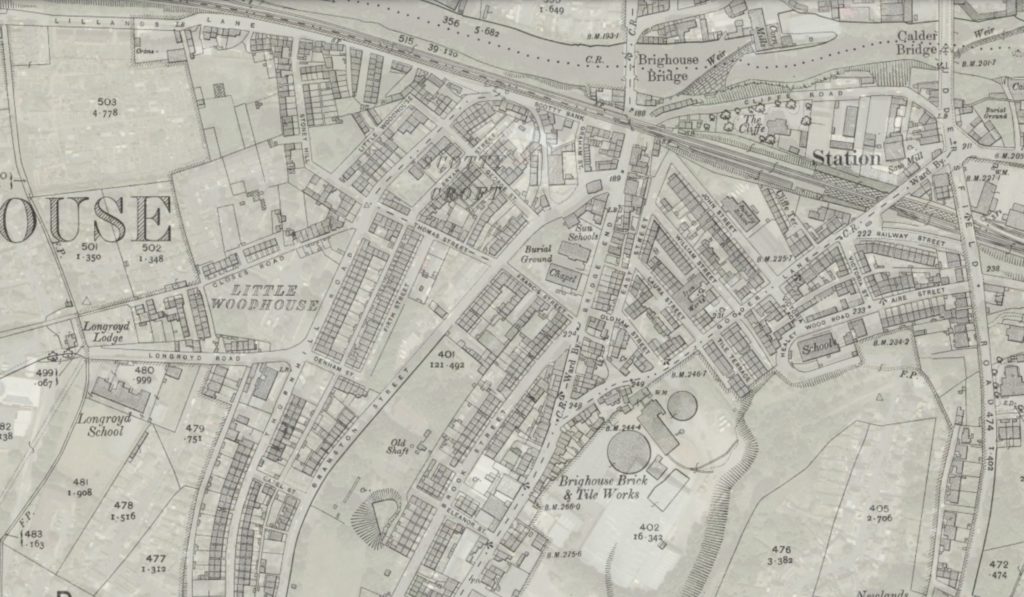
WHITE HORSE PUBLIC HOUSE
We start at the journey at the former White Horse public house on Rastrick Common and I suspect that many people reading this will have their own memories of the pub until it closed in recent times. The successful football team, the indoor games league teams and the general friendly atmosphere and banter that took place within this ‘local’ will be fondly remembered. No doubt many people will be able to recount stories of memorable events which took place within its walls, that will live them forever. Being an old building, there have been numerous incidents connected with that place, which have been consigned to the annals of history. One such story concerned a chimney stack at the pub which was struck by lightning in 1904, causing it to collapse and crash through the roof into the rooms below, fortunately, without harming anyone.
Going back even further than that, to September 1867, the cottage gardeners of Rastrick held their first annual Rastrick Vegetable Show at the beer-house, the landlord at that time being William Naylor. The Huddersfield Chronicle reported that ‘the exhibits were of a first class character,’ and included celery, potatoes, red cabbage, carrots, cabbage etc.
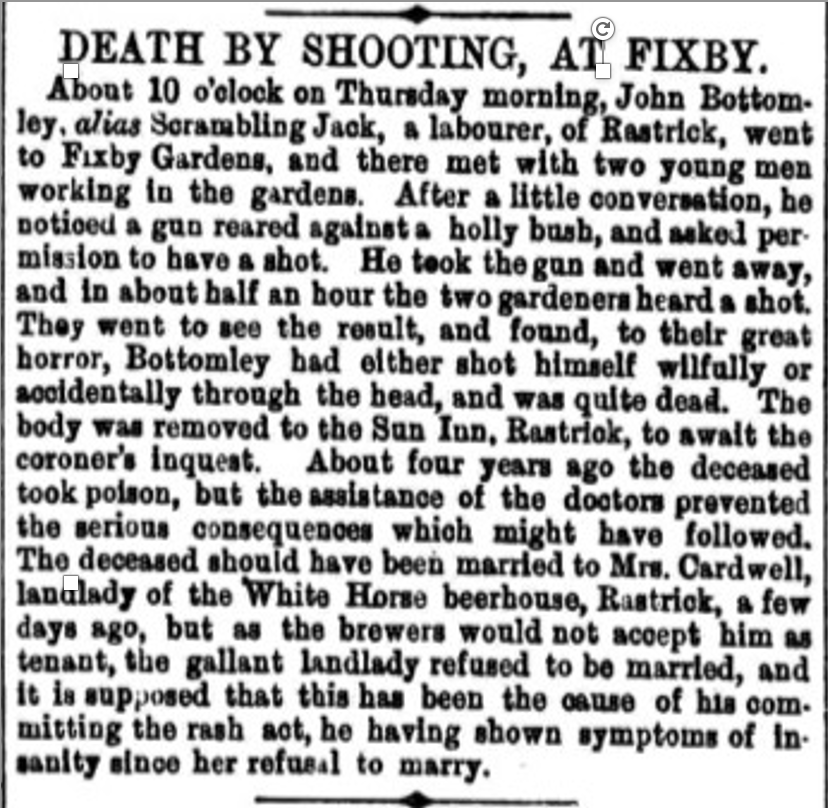
By 1871, James & Sarah Cardwell were running the White Horse and in October 1874, James was fined after being found guilty of permitting drunkenness at his beer-house. He died In 1876 aged 52 years at which point Sarah took over the licence. This was the second time that she had been widowed but undaunted, she became engaged for a third time. Her latest suitor was a Rastrick character by the name of John Bottomley, known locally as Scrambling Jack. Unfortunately for the soon-to-be couple, the brewery owners of the establishment refused to allow him to become a tenant. Sarah, not wishing to lose her livelihood, promptly terminated their engagement. Scrambling Jack Bottomley was very upset at being rejected and a few days afterwards, whilst walking in Fixby Gardens, he came across two gardeners who had a gun with them. Bottomley asked if he could ‘have a shot’ with the weapon to which the men agreed and he went off with the gun. Half an hour later, the two men heard a shot and upon investigating, they found Bottomley had shot himself in the head. It transpired that this was not the first time that he had tried to take his own life as he had attempted to poison himself four years previously.
Sarah must have been a feisty character as she was summoned before the magistrates in 1882 for refusing to allow the police admission to the pub when it was suspected that she was serving customers on the Sabbath. She never married again and died in 1895.
DOG & GUN PUBLIC HOUSE
There was another pub in close proximity to the White Horse. This was the Dog & Gun which was located at what is now known as Eleanor Street, the little unadopted road between Rastrick Common and Brook Street (plans were submitted for a new road called Eleanor Street in September 1877). In 1871, George Jagger (33) was the beer-house keeper along with his wife, Hannah. He was succeeded by Jabez Lancaster and his wife Mary Ann and shortly after taking over, they persuaded the organisers of the Rastrick Vegetable Show to move their exhibition from the White Horse to the Dog & Gun. It finally closed on the 26th December 1932, the last landlord was Alf Rushworth.
TURNPIKE ROAD
In the 1871, Rastrick Common was called the Leeds & Elland Road on the census records. The Huddersfield and New Hey Turnpike Road had been created in 1806, a road which ran from New Hey in Lancashire, through Denshaw, over Buckstones to Outlane where it travelled down New Hey Road into Huddersfield. A branch road was also created that went from Outlane and down into Rastrick. At the top of Jumble Dyke, the road merged with another turnpike road that came up from Elland via Lower Edge and then went down Ogden Lane and Rastrick Common into Brighouse where it crossed the river via Snake Hill Ford, near to where the Huddersfield Road bridge now stands. In the 1871 census, some of the houses on Rastrick Common were classified as being on the Leeds & Elland Road because of the above connection. There is more information about the turnpike roads of Rastrick via this link:- https://myrastrick.com/turnpike-road-in-rastrick/
GOODAIRE MANUFACTURING CHEMISTS
In the late 1850’s, Joseph Goodaire (1811-1885) and his twin brother Benjamin (1811-1877) took over a manufacturing chemist and drysalter business near to the Dog & Gun beer-house. The company was known simply as J. & B. Goodaire. The term ‘drysalter’ was another name for the manufacturers of dyestuffs for the textile industry. Joseph had followed his father into the tailoring business whilst Benjamin had trained to be a joiner so just how they became manufacturing chemists is a mystery. Joseph’s son, James and three of Benjamin’s sons, John Heaton, Joseph (jnr.) and William all followed their fathers into the business but by 1898, there were just the two brothers, Joseph (jnr.) and John Heaton remaining. John Heaton Goodaire decided to retire to Fylde coast leaving Joseph to continue the business alone which he did until his retirement in the early 1900’s. After closing, the building was initially taken over by Millers Oils, situated on the opposite side of Rastrick Common. The pictures below show the newspaper advert announcing the dissolution of the company in 1898 and a photograph of Joseph and Benjamin Goodaire with their wives and children.
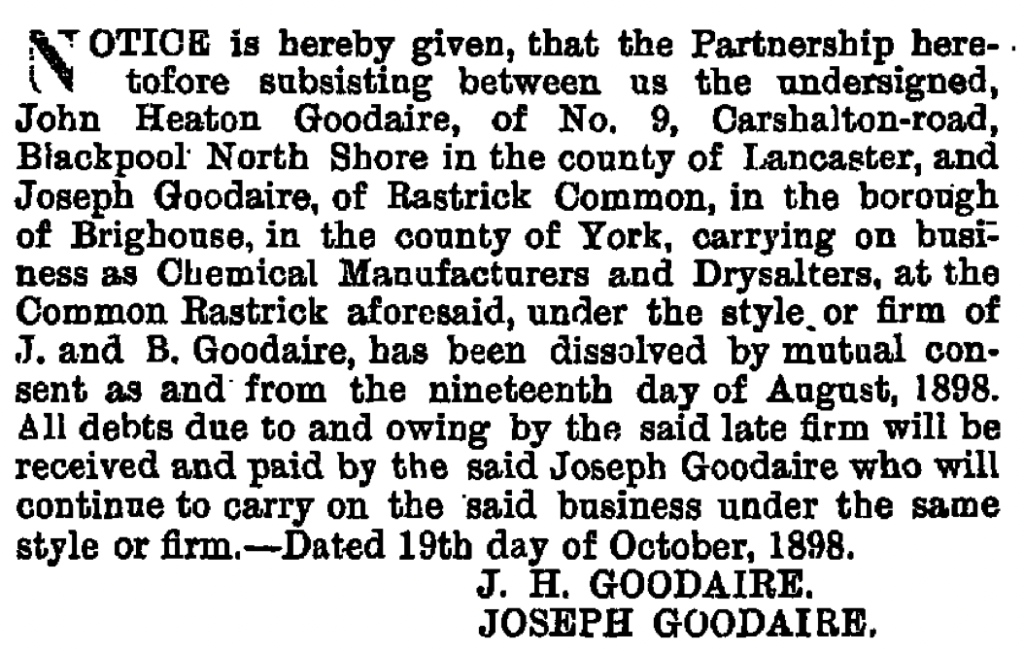
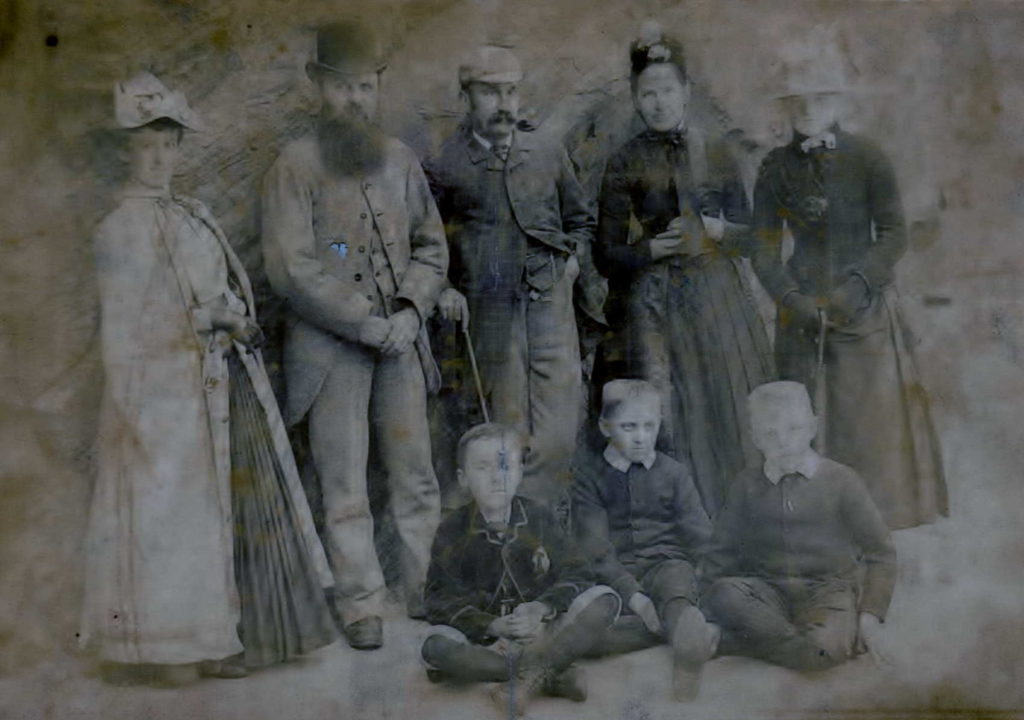
MILLER’S OILS
Nestling under the cliffs below Healey Wood is Millers Oils, a company that has been in Rastrick for over 130 years. John Watson Miller, pictured to the right, originally bought the company 1887 for £265 and changed the name to Millers Oils two years later. He then wrote to all of his customers assuring them that ‘the quality of my oil will be rigidly adhered to’.
Early successes for the company included a gear oil for the Ford Motor Company and specialist engine oil for trucks. The business continued to grow based upon speciality oils for which it has been awarded many prizes over the years. The company has continued to thrive upto this present time.
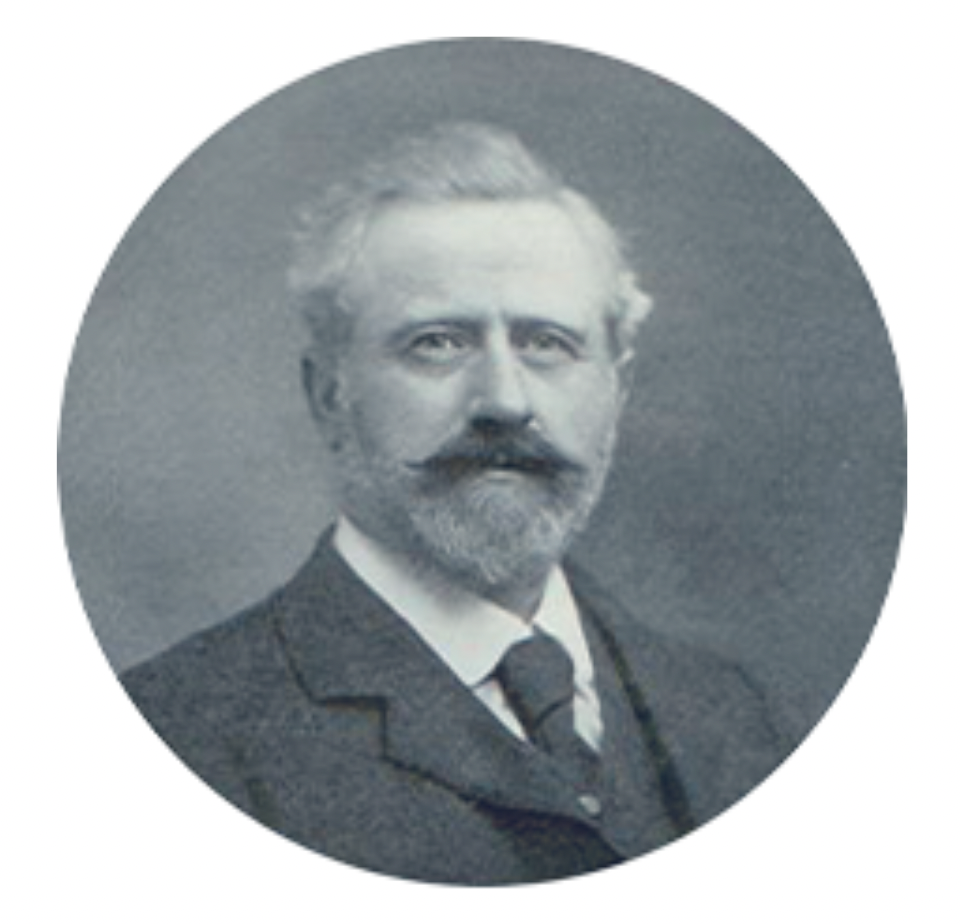
THE RASTRICK BEAR
It was close to this location in the 1950’s that a bear suddenly appeared in a large cage on a trailer. A few people can still remember it and talk about taking food for the bear. A lady by the name of Cora Pickles had a fish and chip shop opposite the White Horse. One night, a clown from a circus at Hope Bank in Huddersfield knocked on her door and told her that the circus had shut down and he needed somewhere to park his trailer and cage that contained a bear. Apparently, the bear was called Bobby and was a full-grown Himalayan Bear. It was black with a white “V” on his chest. He had heard that Cora was in show business and thought she might help him out. She allowed him to park the trailer behind the fish shop, temporarily; he thanked her and left, never to be seen again!
Bobby the Bear stayed there for a long time and wasn’t a great problem, except for once, when Cora’s father forgot to knock on the cage door when taking Bobby’s evening fish & chips supper and the bear, taken by surprise, had bitten him. Cora had difficulty in convincing the ambulance service she wasn’t a hoax caller, as bear bites were something of a rarity in Rastrick. The bear disappeared as rapidly as it appeared as one day, it was suddenly gone. Apparently it ended up in a private zoo.
BRIDGE END CO-OPERATIVE STORE
Moving down the Common to the junction with Bridge End, the old Bridge End Co-Operative store can be seen on the left-hand side of the road. By 1870, the Brighouse Co-operative Society was expanding at such a rate that new stores were springing up all over the area. The Bridge End store was built on land acquired by the local solicitor Fairless Barber in 1870 and was opened to customers on the 26th August 1872. The first storekeeper was Alfred Pilling who had previously worked at the central store in Brighouse. A slaughterhouse was originally built at the rear therefore the local residents could be assured that the meat was fresh as the animals were killed just a few yards from the tills. The first butchery department manager was John Lancaster, son of Jabez Lancaster who was the manager of the butchery department at the Central Store in Brighouse. There was no doubt that the Co-op looked after their own in those early days and if your face fitted, the work prospects were endless. Many who started in those early days worked their entire lives at the Co-op and in numerous cases, several generations of a family found employment with them.
The Bridge End slaughterhouse served the store for around fifteen years and was closed when the Society opened a central slaughterhouse at The Lees off Mill Lane in 1897. The Bridge End slaughterhouse was converted into a stable for three horses which were used for delivering coal to houses around the locality.
As shopping habits changed dramatically in the 1960’s and with the advent of the larger supermarkets, the Co-op couldn’t compete and as custom at the stores fell into decline, the stores closed one by one. Like many others, the Bridge End store has seen various businesses come and go over the last few decades and it now sits in a sorrowful state of deterioration.
The two photos below show the store shortly after opening in 1872 and a modern photo from almost 150 years later in 2021.
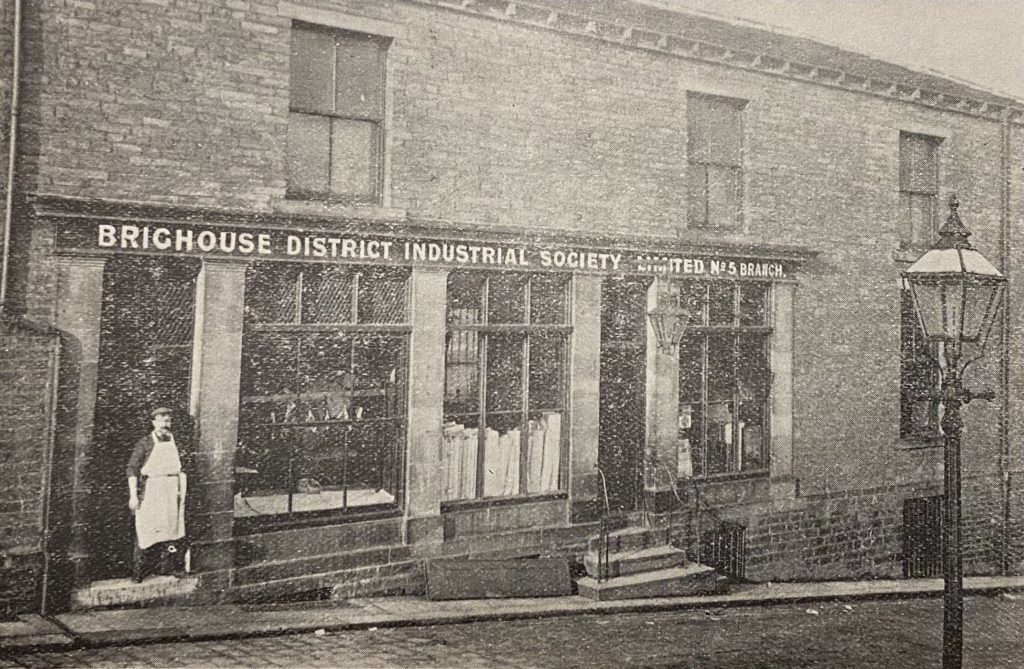
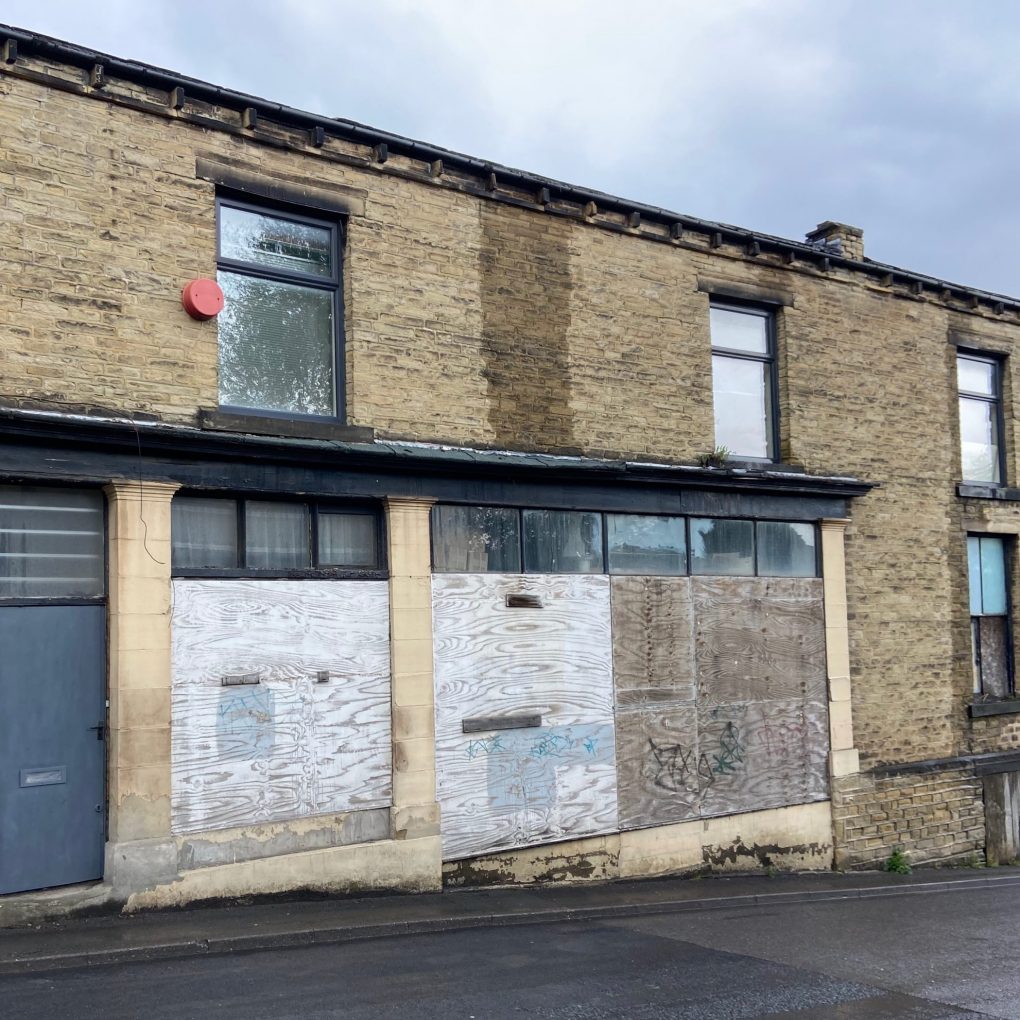
RASTRICK COMMON, GOODER LANE & HEALEY WOOD
Our route heads back up to Rastrick Common where, upon turning left, the road changes its name to Gooder Lane as it travels down towards the Huddersfield to Bradford road. It is not known when or where the Gooder name originated but it was certainly around prior to the railway arriving in 1840 as we will see shortly when it became the centre of a dispute with the railway company.
On the south side of Gooder Lane is the unmistakable view of the cliff face, created initially by escarpment quarrying in the 19th century. The area was previously covered in woodland which was appropriately named Hilly Wood due to the gradient that descended sharply towards the Common at the bottom end of Rastrick. For some reason, this name was later contrived into Healey Wood. The Common was an area in medieval times that was owned by the Lord of the Manor but where the common residents of the township of Rastrick were permitted to graze their cattle, grow crops, collect fallen branches and cut sticks for their own use at home, along with some other minor privileges. It was not permitted to be used by strangers or visitors from other towns and offenders were often summoned to appear before the court at Brighouse. The court was known as the Turn and in October 1600 it imposed fines of 6d each upon four Brighouse men who had ‘placed their horses on the Common at Rastrick’.
The various Enclosure Acts from 1604 onwards created a change to the usage of the Common as the land was gradually transferred into private ownership. Walls, fences and hedges were erected as the land was steadily sub-divided. I am not certain what year it was privatised but the Brighouse Turn was still regularly fining Brighouse people for putting their cattle or oxen onto the Rastrick Common, into the 1620’s. One name that repeatedly appears at court is that of Fflather, a name that also emerges in Lightcliffe in the early 1700’s.
The first mention of an enclosure on the Common at Rastrick that I have seen comes in 1684 when a grant for 1,000 years for a parcel of land ‘was made in trust for the benefit and mainteynace of such preacher or minister for the tyme beinge as shall preach the word of God in the chappell of Rastricke commonly called St Matthew chappell year to year at 5s 4d yearly rent; 4s a month rent if there be no minister.’
On the map to the right which dates from 1824, Rastrick Common runs up the centre before splitting at the top of Bridge End, where Gooder Lane forms the right fork in the road. What used to be the Common, on the right-hand side of the road, has been enclosed into fields or closes, all of which were given names. It can be seen where the road names for the much later Scholey Road and Avenue came from as many of the closes had that name. There was a track leading off Gooder Lane towards Hilly Wood which was located somewhere near to where the Brick and Tile Terrace housing is now situated. Beyond that are two enclosures called Newlands which had been bisected when the Huddersfield road was built. The section under Hilly Wood is where Victoria Street, Aire Street and the former Victoria Central School are now located.
The below photograph from 1949 shows Gooder Lane at the junction with Bridge End.
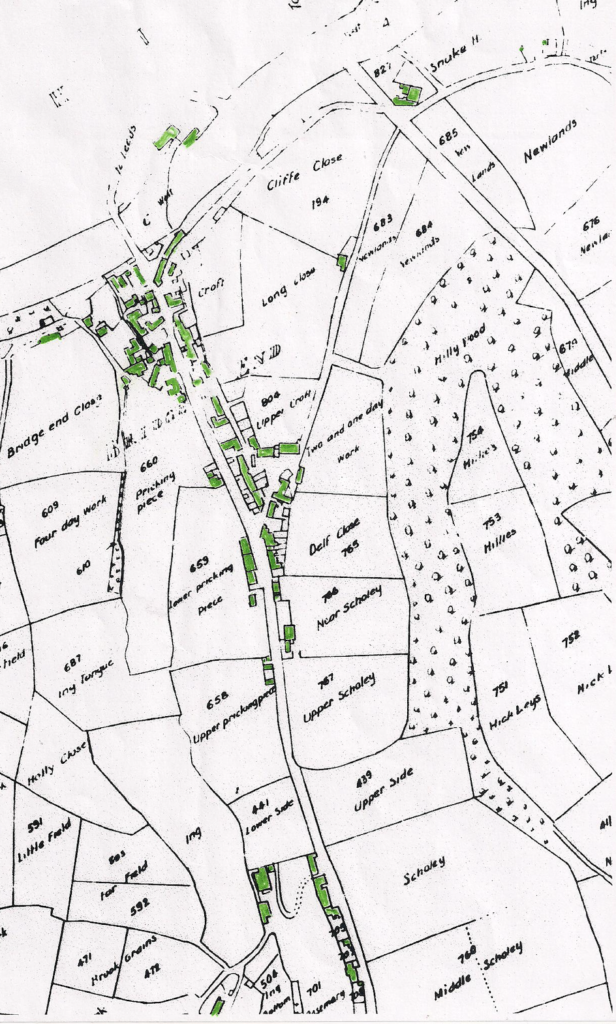
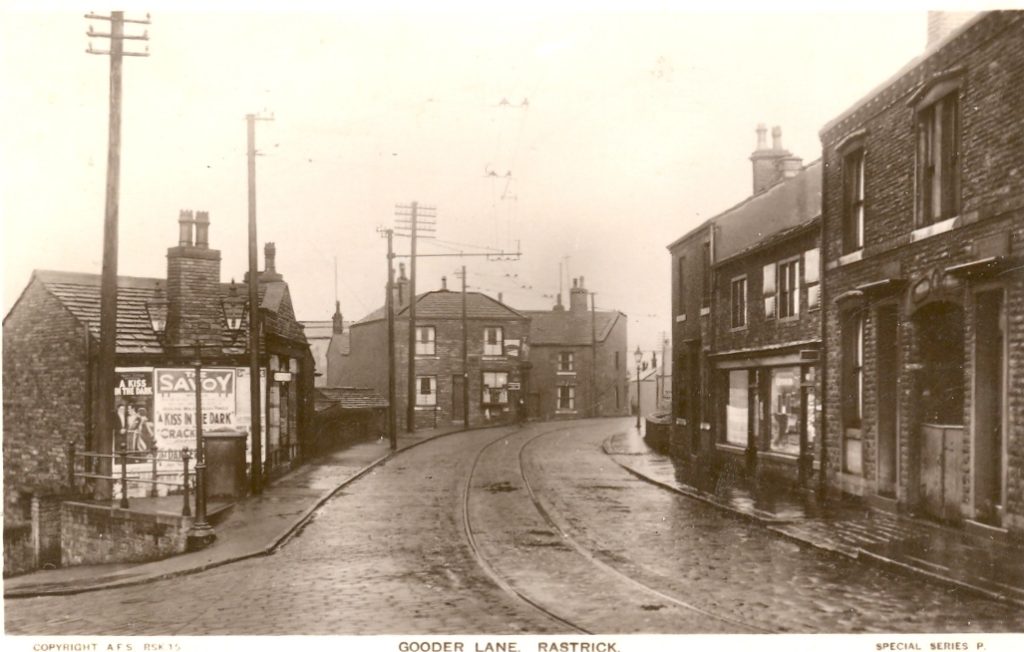
BRIGHOUSE & RASTRICK BRICK & TILE COMPANY
At the Brighouse Turn in October 1599, unsurprisingly, the name of Fflather once more appears. Richard Fflather appeared after he ‘dug and led away slatestones from Rastrick Common’. This suggests that some form of quarrying was already taking place at this location in the late 16th century. Quarrying continued for in excess of another 350 years and many thousands of tons of stone, slate and clay were removed, leaving the Hilly Wood slope down to the Common as a cliff face.
In the 1850’s, brothers James and George Dyson, stone masons, were working the Gooder Lane quarry but when extensive and fine quality clay deposits were unearthed, they expanded their business to include brick making. The Brighouse and Rastrick Brick and Tile Company was created, later to become the Brighouse Brick, Tile and Stone Company Ltd. Following George’s departure, James was joined by his younger brother, John Exley Dyson who at the time was living with his wife at the Star Inn at Bridge End, a business owned by her parents. There will be more about him later in this story.
In 1868, the company were successful in tendering for the provision of fifteen million bricks to the London & North Western Railway who were going to build a second railway tunnel through Standedge. This involved supplying 115,000 bricks per week for two and half years, creating additional employment for a number of men. It was probably as a result of this order that during the following year, the company announced that work had started on their new eight chambered brick kiln that was capable of firing 400,000 bricks at one time.
This didn’t go down well with everyone as a Mr. Robert Buckley complained to the Rastrick Board that the wall of one of the kilns was so close to his house that his home was being constantly filled up with smoke during the firing process. The Board issued an abatement notice until the problem was rectified. Looking at the map from 1894, it shows the extensive clay pit that travelled adjacent to the Common from the junction with Bridge End up to the Rastrick Common Board School. New housing for the workers was erected nearby and appropriately called Brick Terrace, Tile Terrace and Brick and Tile Terrace. The buildings were taken over in the late 1990’s by a housing association and have now been rendered and painted.
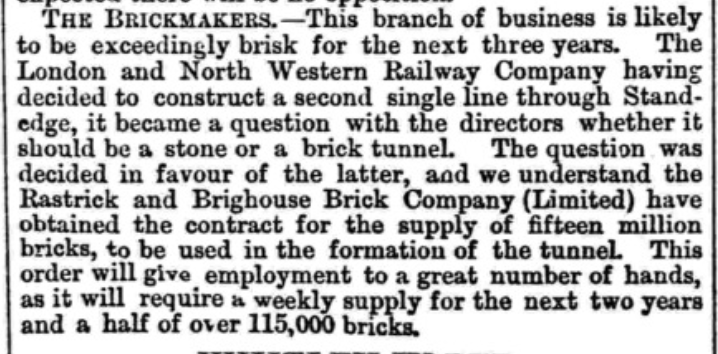

Newspaper reports from 1869 reporting on the massive order for bricks to build the Standedge Tunnel (left) and the building of the new kiln capable of holding 400,000 bricks at one time (right).
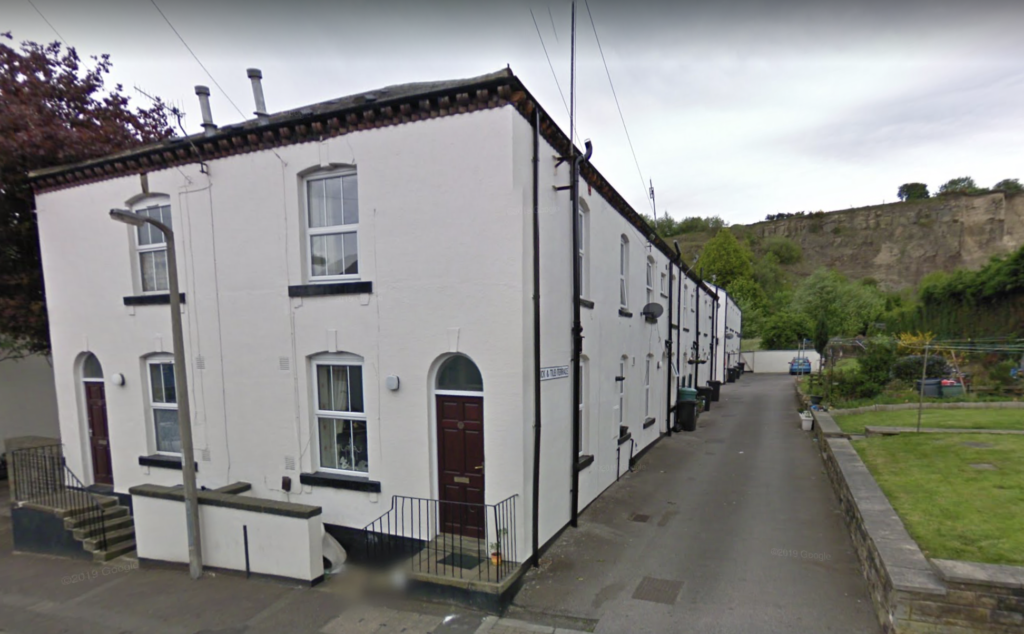
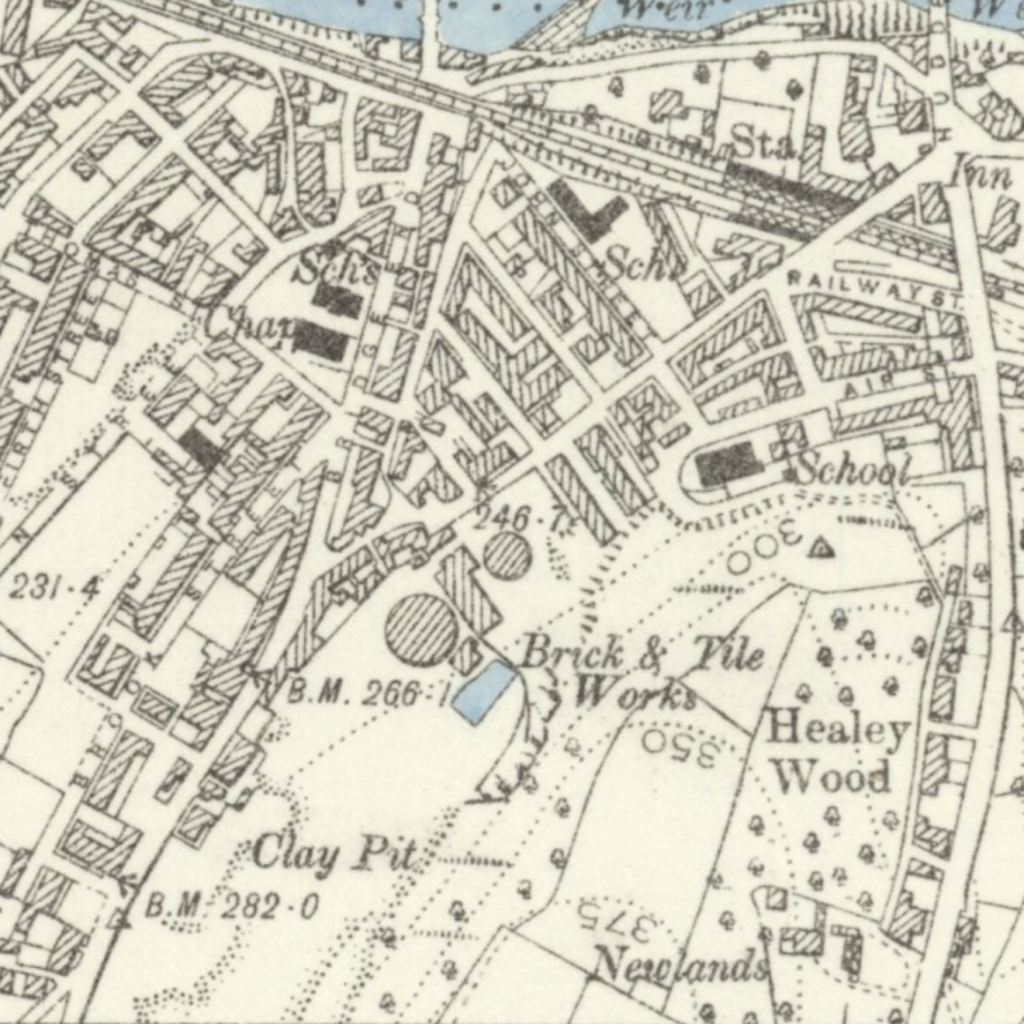
The above photo on the left shows the houses at Brick & Tile Terrace with the iconic cliff face of the old quarry in the background whilst the 1894 map on the right shows the area of the brickworks at that time. Notice how there are clay pits extending in a south-westerly direction, beyond where Miller’s Oils is now located
By 1877, the company had bought two further brick manufacturers in Huddersfield and Littleborough and were making around 250,000 bricks per week. The Rastrick company employed almost one hundred workers at the end of the 19th century but this turned out to be the peak of its trade. Manufacturing declined with the advent of cheaper competition and the business closed in 1962. I’m not sure exactly what year the chimneys and kilns were demolished but I can remember going there as a young boy in the mid 60’s and playing inside the huge kilns. My abiding memory of this once proud company however, is that it was a great place for catching newts and finding frogspawn !
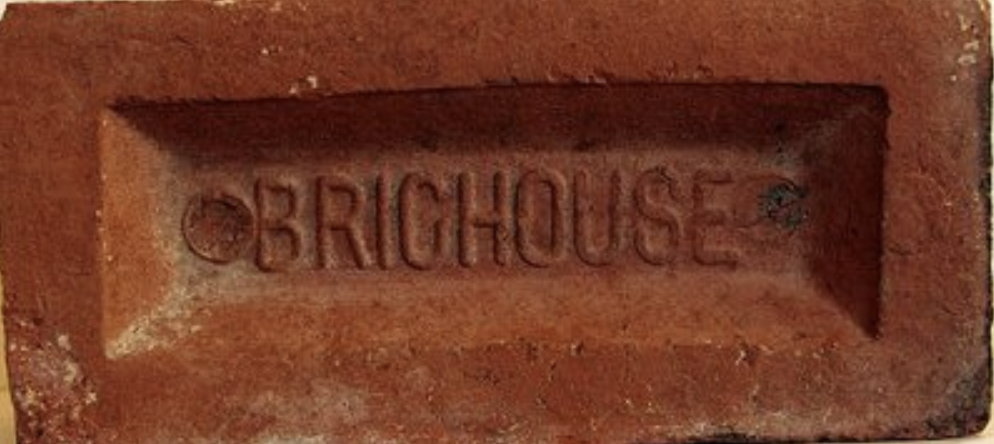
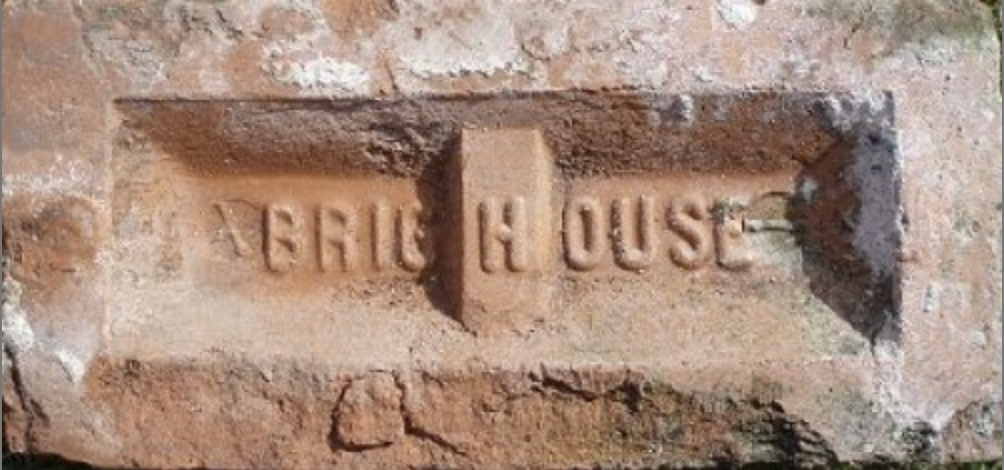
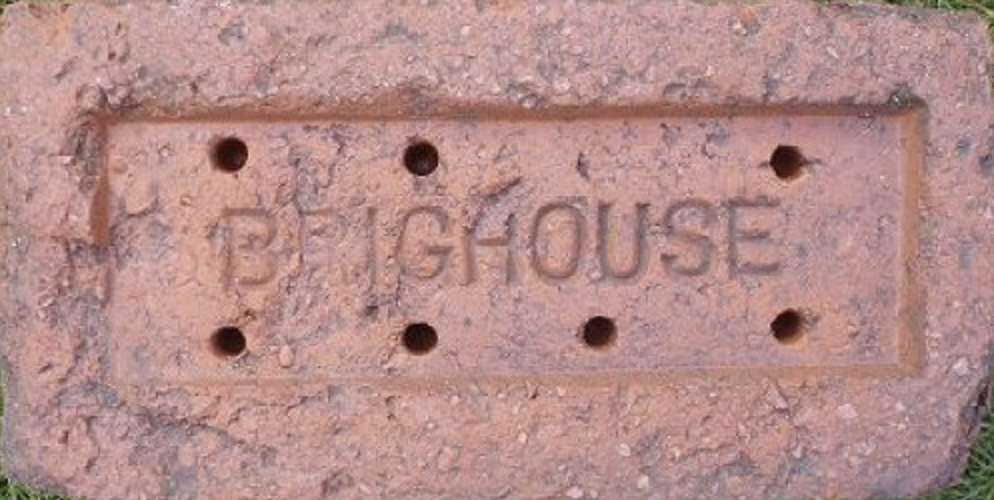
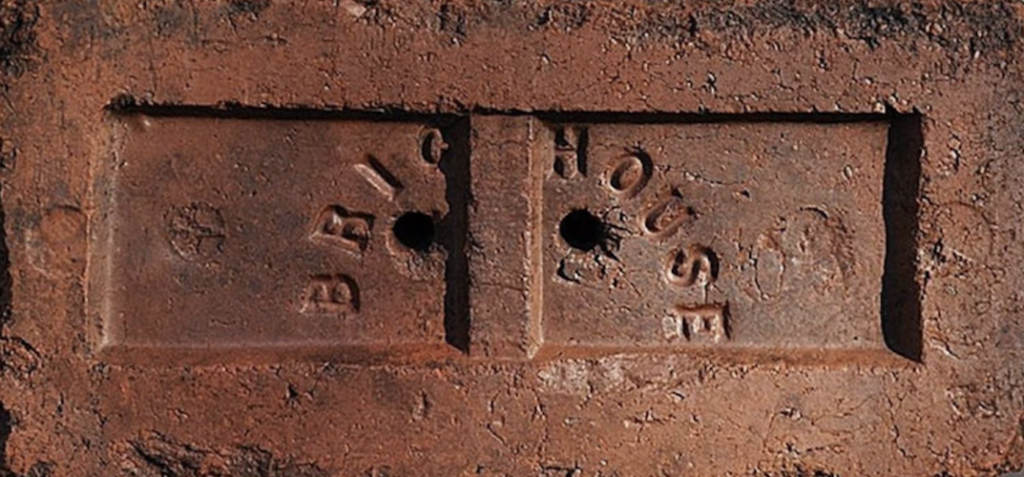
Four examples of bricks made by the Brighouse & Rastrick Brick & Tile Company. My house dates from 1938 and is built from the example on the left, a solid engineering brick that is a nightmare to chisel, when chopping out holes for electrical sockets. The photos are from the Frank Lawson Collection and are produced with permission.

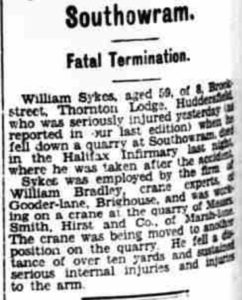
WILLIAM BRADLEY & Co– CRANE MAKER
A little further down Gooder Lane, on the opposite side of the road, was William Bradley & Co, engineers and crane makers.
William Bradley was born in 1833 at South Crosland, Huddersfield and was the son of John Bradley, a farmer. William’s father died when he was quite young but his mother continued to farm the ten acres of land that they leased, however, William decided that farming wasn’t for him.
He trained to become a millwright, an old term for a mechanic who repaired the breakdowns in mill machinery. He married in 1855 and was still living at South Crosland in 1861 but had moved to Gooder Lane, Rastrick by 1871. He set up his own business and in 1875, plans were submitted by the architects, Edwin Heaton of Brighouse for William Bradley to build an iron foundry in Gooder Lane between William Street and Laura Street. In the 1881 census, William is shown residing at William Street and was employing three men, five boys and two labourers, including two of his sons, Fred and Arthur.
Following the death of his father, Arthur continued in the business. One of the company adverts describes them as engineers, ironfounders, millwrights and machine makers but they specialised in making steam cranes for the stone quarrying trade. They also made grinding pans for the brick making industry and fibre recovery machines for the textile industry.
Accidents were frequent in the engineering trade and a newspaper story from 29th October 1932 reported on an accident at the Marsh Lane quarrries, Southowram where Jonathan Willie Sykes, an employee of Wm. Bradley & Co, who had attended to carry out some maintenance on a Bradley crane, lost his life after falling over 30 feet. The newspaper had his name as William Sykes but I was informed of his correct name by his grandson, John. William was the name of Jonathan Willie’s son who was also present at the time of the accident as he also worked for Bradleys at that time. William went on to work for the British Engine & Electrical Insurance Co who carried out insurance inspections to prevent industrial accidents and ironically attended a crane accident at Marshall’s quarry, Toothill Bank, Rastrick in 1937 when a 15 ton Bradley crane toppled over and the underground miners were trapped at the bottom of the shaft. William rescued them with a hand winch.
In 1947, two crane erectors who worked for Wm. Bradley & Co. decided to take one of the company’s lorries without consent, to go on a night out in Halifax. After being involved in an accident with a 71 year old lady on Elland Road and failing to stop, they were eventually caught by the police near Salterhebble. Both men received prison sentences and no doubt lost their jobs too.
Many of the above trades that Bradleys were involved with were in slow decline and the company closed after trading for around 100 years.

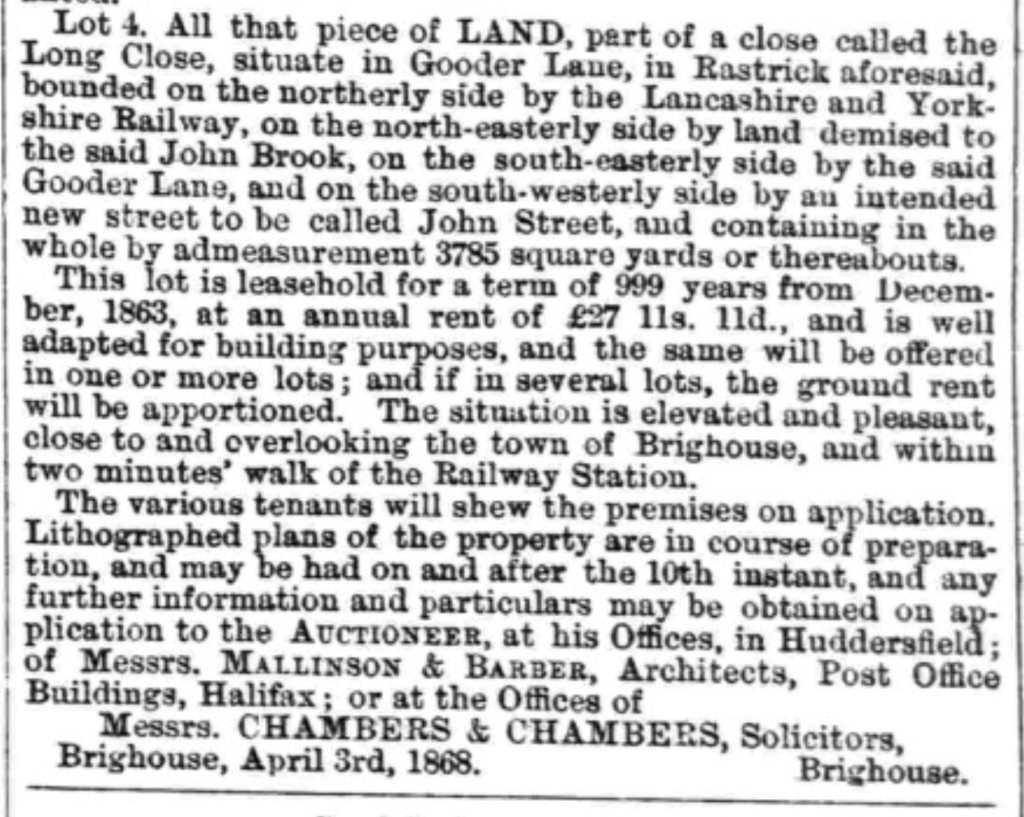
NEW HOUSING AND THE CHURCH OF ST. JOHN THE DIVINE
The increase in local workers resulted in the need for more housing. On the 24th April 1868, an auction was held at the Railway Hotel on Birds Royd Lane. Whilst most of the lots were industrial premises on Birds Royd, Lot 4 consisted of a triangular piece of land with Gooder Lane on one side, the railway on another and with a proposed new road to be called John Street on the third side. In all, it contained around 3,785 sq. yds.
On the 13th May 1874, the area on the opposite side of Gooder Lane known as Newlands was auctioned at the Royal Hotel, Brighouse. This land consisted of the fields between the brickworks, the railway, Gooder Lane and Huddersfield Road. Soon after the land was sold, building commenced with the houses we can still see on Gooder Lane along with more houses on the new roads at Victoria Street, Victoria Place and Aire Street.
During that same year, a new school and mission room, known as St. John’s was opened on the opposite side of Gooder Lane on the land that had been auctioned in 1868. The school was needed to cater for the increasing number of children as the population grew. More new roads and housing had been erected along John Street, Laura Street, William Street and East Street. The building at St. John’s acted as both a day school and a place of religious worship and was in use as the former until 1893 when the Victoria Board School was built on the hill at the back of Aire Street. Upon the cessation of the St. John’s school, the building was dedicated as a mission church by the Bishop of Wakefield and the whole cost of re-modelling was paid for by Mr. Arthur Travis Clay of Holly Bank House, Rastrick who was the chairman of the Rastrick School Board at that time. He also paid for a new organ in the mission church. Land was set aside for the future erection of a new church when funds permitted.
The below left newspaper clips are from the Brighouse News dated 9th May 1874. On the left, it is advertising the auction of land at Newlands. The auction was held four days later at the Royal Hotel, Brighouse. The report on the right concerns the opening of the mission church at St. John’s in that same year.
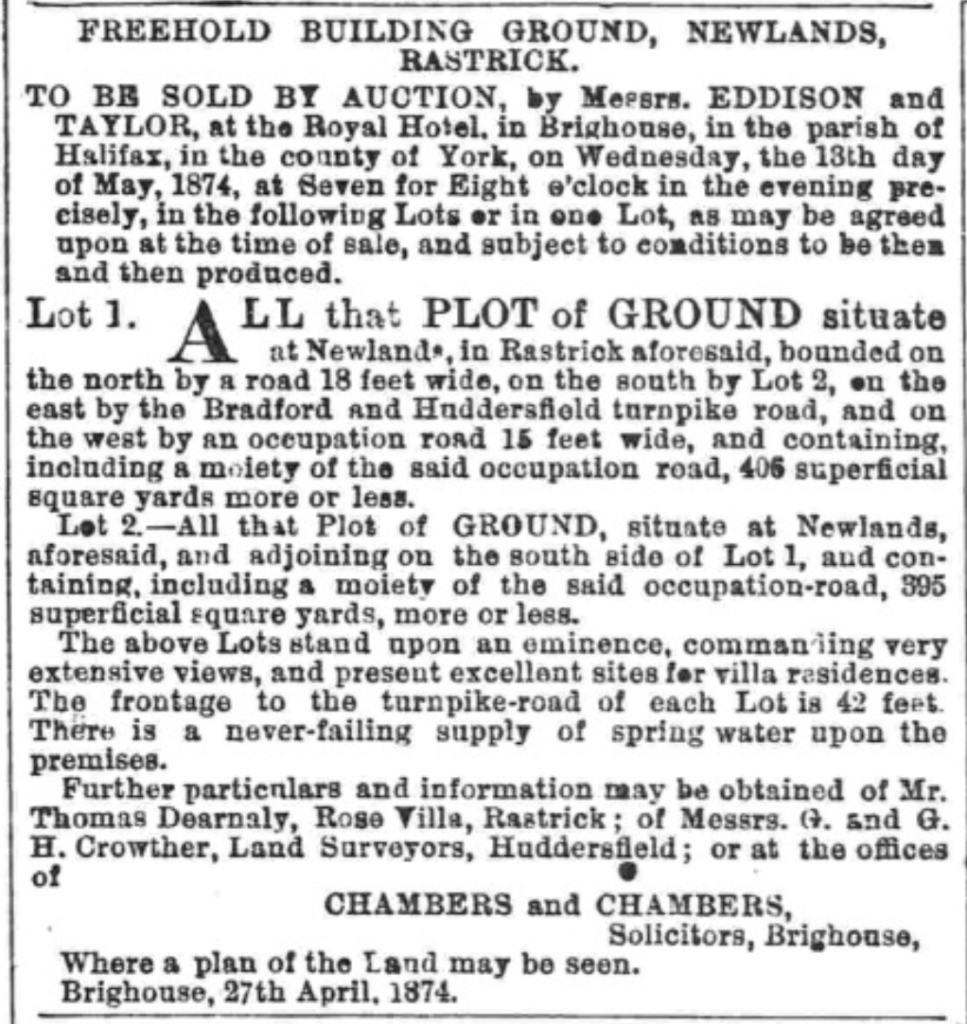
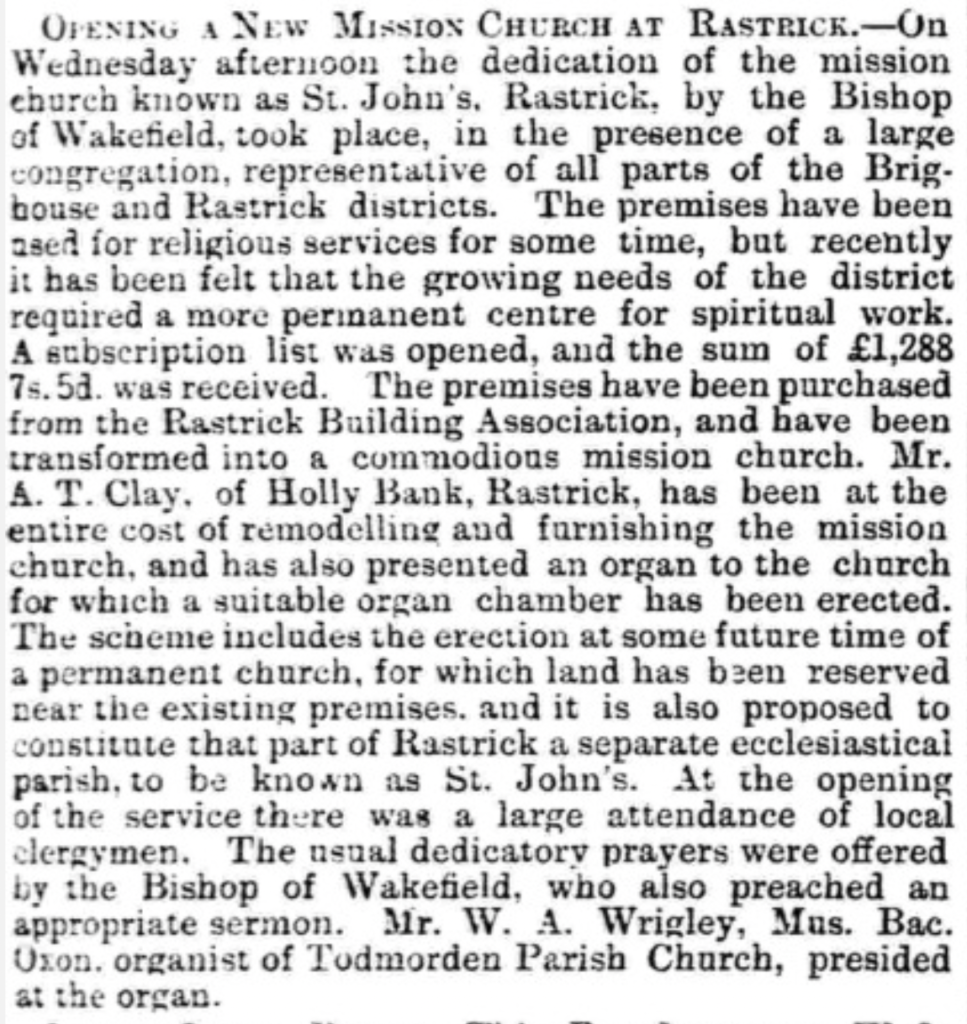
In 1901, the Lancashire & Yorkshire Railway Company decided to widen the railway adjacent to St. John’s and after consultation, land was purchased from the church. The plans involved demolishing the mission church and schoolroom which had only been standing for twenty-seven years. With the compensation obtained from the railway company it was decided to erect a new building. The Brighouse News dated 28th June 1901 stated, ‘it has been decided in the new scheme to omit a separate mission church and to build Sunday schools with a commodious school-room suitable for use also as a mission hall. The new buildings are to be in John Street about eighty feet nearer to Gooder Lane than the existing premise.’
These later buildings still exist and are currently used as the church and community hall. What is peculiar about this story is that the railway company never carried out the works and it transpired that the church buildings were pulled down for no reason. Old maps dated between 1893 and 1922 clearly show that there is no difference to the shape of the land around St. John’s and the only things that changed were the removal of the old and then addition of the new church buildings.
In July 1902, the new schoolrooms were opened by the Bishop of Wakefield but it wasn’t until 1913 that work commenced on the new church which currently stands on the site. It was designed by Sir Charles Nicholson at a cost of around £5,000 and was dedicated on Christmas Day 1914. On the 27th November 1915, the church of St John the Divine was consecrated and in 1916, St John’s became a separate parish from St. Matthew’s until the two were re-united again in 2008.
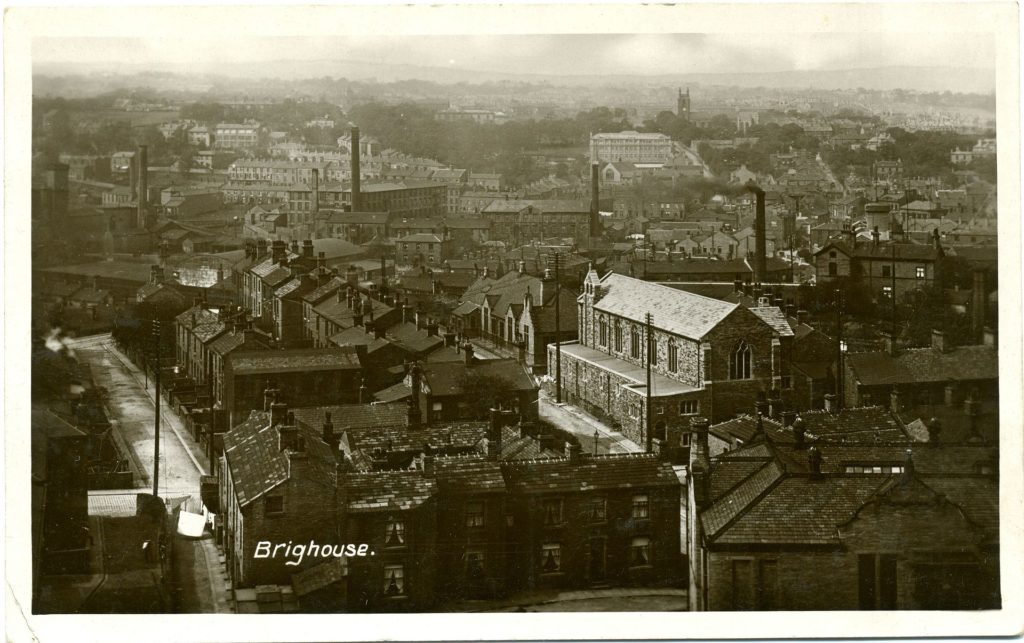
THE RAILWAY
The Manchester & Leeds Railway was opened in October 1840 and despite the station being located in Rastrick, it has always been known as Brighouse, much to the consternation of many Rastrick folk. It was heralded a great success and certainly brought prosperity to the town as indeed the canal had done eighty years before but there is usually a downside to new developments. In this instance the railway company had cut straight across Gooder Lane, blocking what was a major road from Rastrick into Brighouse. An indictment was brought about by the inhabitants of Rastrick against certain senior members of the railway company. The object of the prosecution was to ‘complain of an obstruction which had been caused on the Queen’s highway.’ The prosecution stated, ‘at this township was a lane called Gooder lane which runs from Rastrick to what is called Rastrick Common and thence through several places to Woodhouse. The lane in question was an important one as it was the only road from Woodhouse and that neighbourhood to church – it was a road by which persons in the neighbourhood of Rastrick belonging to the Society of Friends, approach the Quakers’ meeting-house, which is not far from the point where Gooder lane is intercepted by the Huddersfield and Bradford road. At Rastrick there is a very large stone quarry and a great part of the stone flagging in London is supplied by this place. The stone taken from this quarry (Southage’s at the rear of the former Junction public house up to Carr Green) is taken down Gooder lane to the Calder, thence it is taken to Selby where it is shipped for the London market.’
The Rastrick township residents were unhappy because at the time of the opening of the railway, the company proposed that traffic would be allowed to cross the lines by means of what we now know as a level crossing, but it appears that they later changed their minds. Instead, they built a wall on the Rastrick side of the railway and put ditches on each side of the actual rail lines. The inhabitants demanded that the railway company remove the obstructions, but the railway authority were insistent that the road would not cross the railway at this place. They also said that they would not provide a manned level crossing despite laying the foundations for a cottage to be occupied by the gatekeeper, nor would they build a bridge to pass over the railway. Instead, they would build a new thoroughfare towards the Huddersfield to Bradford road and traffic could then cross the railway via that road-bridge which was already in place. One has to bear in mind that there were very few houses in the area at that time and it was still mainly fields so putting in a new road would not be a major issue for them.. Railway Street didn’t yet exist, and it appears the proposed road was somewhere near to what is now Victoria Street. The land ascends towards Aire Street and then heads along the level to the Huddersfield to Bradford road before descending over the railway bridge towards the Calder river bridge and then onto the canal basin. The inhabitants complained that this detour rose up a 1:22 gradient before descending a 1:13 incline on the Huddersfield to Bradford road. A single horse had previously been sufficient to take cart loads down to the canal wharf but ‘it was perfectly impossible for one horse to draw the same quantity along the diverted road, in consequence of the ascent on the one side and descent on the other. Formerly the road went nearly on a level. If the company would only agree to give the people of Rastrick a bridge, they would be satisfied: or more, if the company would consent to put up side-gates and let them cross the railway road on a level.’ In other words, build a level crossing.
The railway company responded by saying the additional cost for making the requested alterations would be between £1,080 and £1,100 for something that was not required. It then described the court action as ‘a trifling and trumpery case,’ which in modern parlance would mean petty, unimportant and nonsensical. In summing up, the Learned Judge stated that he ‘disapproved the practise of railways crossing highways on the level’ and after consulting for half an hour, the jury found a verdict substantially against the railway company.
At the same time as this court case was being heard, a second case was simultaneously taking place involving John Holroyd, Surveyor of the Highways for the Township of Rastrick, who was charged with obstructing the railway in a manner that endangered the lives of her Majesty’s subjects. This Leeds Mercury report into the case throws more light upon the story as evidence was given that during the building of the railway, the Manchester & Leeds company, despite having completed the diversions mentioned above, ‘had still allowed Gooder lane to remain open for the convenience of the people of Rastrick and others, until the line was opened for the conveyance of passengers. Immediately previous to the opening of the railway on the 5thOctober, the wall referred to in the last case, and which stopped-up Gooder lane, was built and the two ditches dug, so as effectually to shut up the old road in order that no danger might be incurred. On the 8th October, Mr Holroyd, taking up a feeling of hostility to the railway company, which was prevalent in the neighbourhood, determined he would restore the old road. Accordingly, some men took down the wall and Holroyd and some others filled up the ditches. It was therefore found necessary to empty the ditches again, in order to secure the safety of the passengers. This was done on the 8th October when the defendant and some of his men came up, and while the men belonging to the party were wheeling the earth out of the ditches, upset the barrows, lodging their contents on the rails and in spaces between the rails, thereby obstructing the line, insomuch that a coming train would have been overturned, had not the police given a signal, and thereby stopped it until the obstruction was removed. It was said that Holroyd had done so for the purpose of trying his right, but no man had a right to do so wilfully and obstinately. The Company were extremely anxious that it should be made known that people had no right to cause obstructions by which the lives of so many passengers were endangered.’
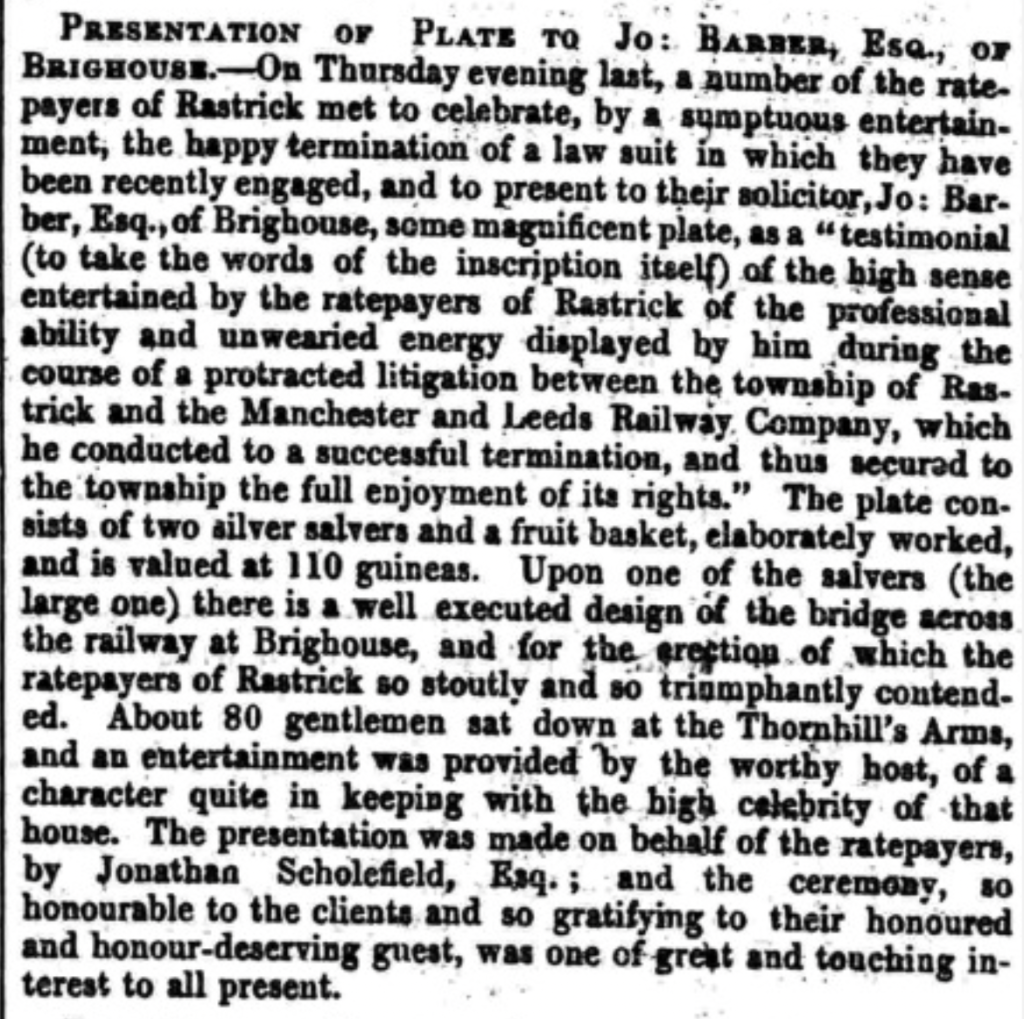
The defence team argued that the case had only been brought to court by the railway company purely for the purpose of punishing Mr. Holroyd under an Act which was not at all applicable to the case. Witnesses were called and many stated that the barrows were turned over when a scuffle ensued between the two parties and that it was not a deliberate act by John Holroyd. After several hours of deliberation, the jury could not come to a verdict and were discharged.
The Gooder Lane saga continued in the courts until 1845 when the inhabitants of Rastrick finally won their lawsuit battle against the Manchester & Leeds Railway Company and they were forced to build a bridge on Gooder Lane thus allowing traffic to cross the railway unhindered. The Bradford Observer dated 30th October 1845 reported on the victory celebrations at the Thornhill Arms at the Top o’ Town, Rastrick where a ‘magnificent plate’ was presented to the solicitor, Joseph Barber for his efforts in securing the victory. The plate consisted of two silver salvers and a fruit basket which was valued at 110 guineas (approx.. £15,000 in today’s value).
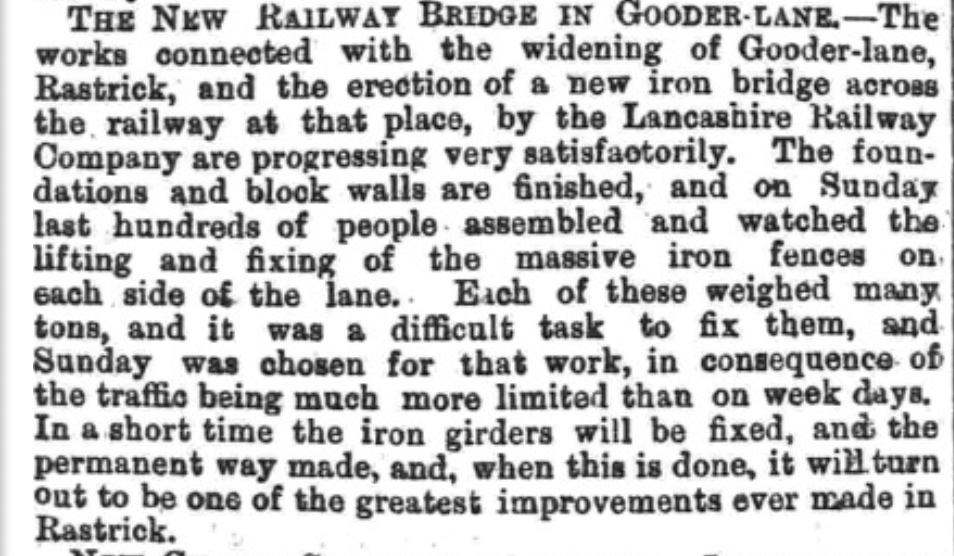
From contemporary newspaper reports, it is evident that the 1845 bridge was only about 15 feet wide and was made of iron. It was replaced in 1874 as the newspaper cutting from the Huddersfield Chronicle dated 20th June shows. Gooder Lane was widened resulting in a new bridge being required. The sides were made of iron, weighing several tons. They were lifted into place before the cobbled roadway was laid. It was hailed as one of the greatest improvements ever made in Rastrick. It didn’t take very long for the first accident to occur however. On the 28th August that year, a horse was drawing a heavily laden coal cart over the bridge towards the Huddersfield Road. Due to the slippery state of the cobbles on the incline, the horse lost its footing and fell heavily to the ground. Due to the shocking state of its leg injury, it was thought that the horse would have to be destroyed (Huddersfield Chronicle 1st September 1874).
The bridge is still in place to this day.
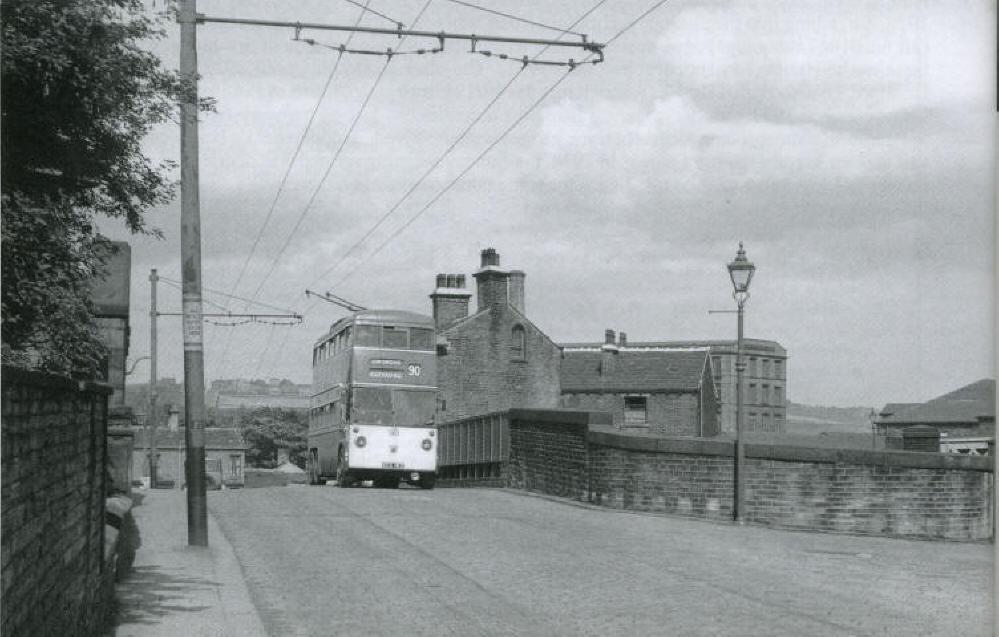
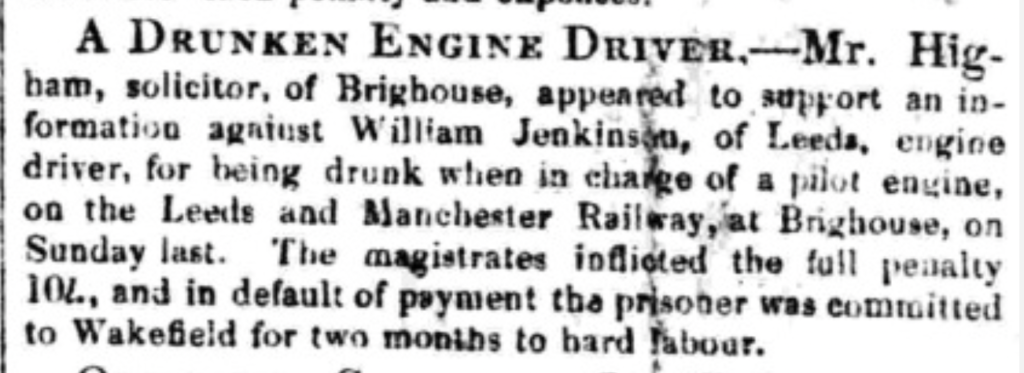

The build-up to the opening of the railway on the 5th October 1840 didn’t go particularly smoothly. Two days before the official opening, a pilot engine was driven along the route by William Jenkinson of Leeds. Whilst stationary at Brighouse, Jenkinson was arrested for being drunk and was fined the maximum amount of ten shillings. He was unable to pay the money and on the 8th October he was committed to the Wakefield House of Correction for two months.
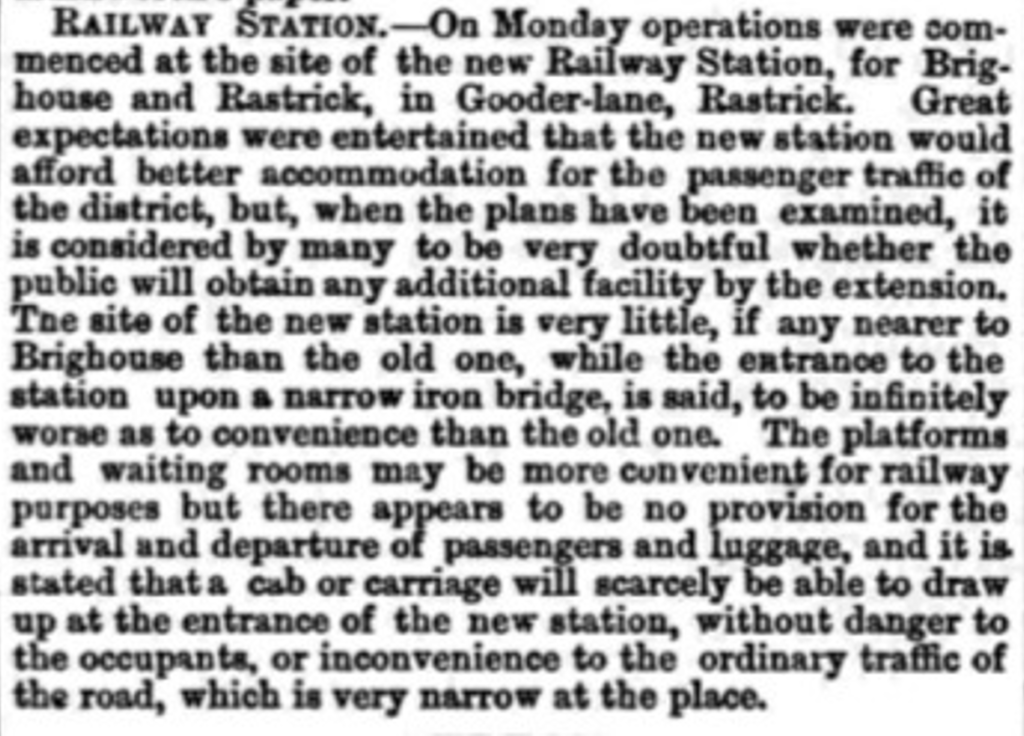
NEW RAILWAY STATION AT GOODER LANE
People had been calling upon the Lancashire & Yorkshire Railway Company to provide an updated station for several years and in 1870, plans were revealed in the Brighouse News dated the 16th July but even when it opened, there were dissenters who found fault with the new building by saying it wasn’t any closer to Brighouse than the old one on Birds Royd Lane. There were also complaints that the road was narrow and cabs wouldn’t be able to pull up outside without it being dangerous to the passengers. This was another reason why the original 1845 bridge was replaced.
In January 1878, it was resolved at a meeting of the Local Board that on the gas lamp at the Huddersfield Road entrance into Gooder Lane, the words ‘TO THE STATION’ with a hand pointing in that direction, should be painted onto the glass.
The photo below shows the outside of the 1870 Gooder Lane station entrance in the 1960’s.
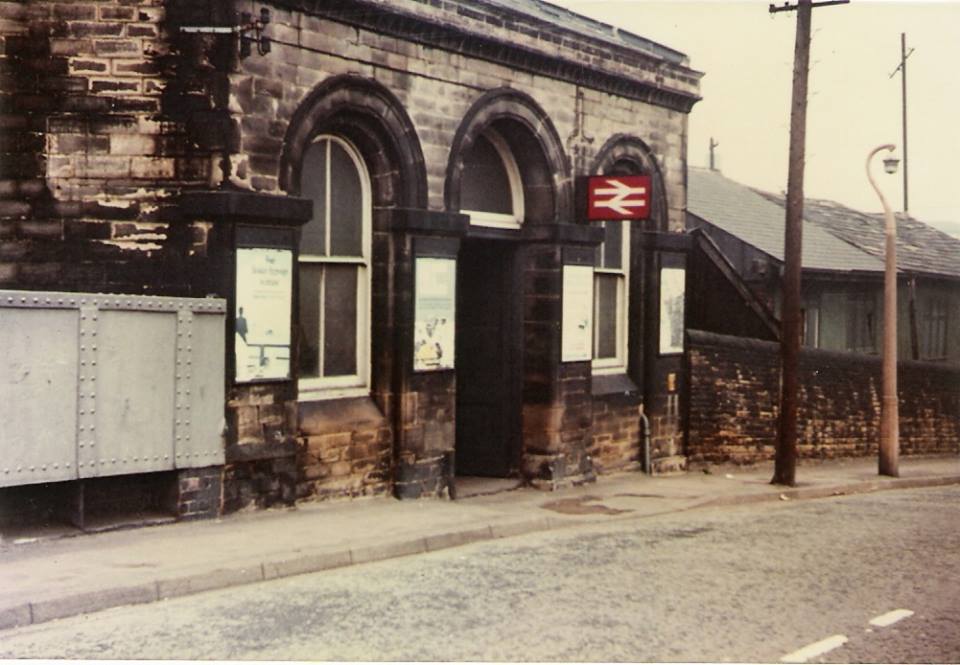
Reading through the old newspapers, there are some fantastic stories of occurrences at the railway station that could be made into an interesting book. The accounts include horse drawn cabs colliding on the road outside, a cab driver dropping dead whilst waiting for a passenger, a station worker falling off a ladder whilst fixing a light in the signals with fatal consequences, the welcoming home of soldiers returning from the Boer War in South Africa, people being killed whilst crossing the lines, fighting amongst passengers, Brighouse Rush Week, when 5,000 people departed from the station in just one day, fatal train crashes, thefts, suicides and even a baby elephant breaking out of its carriage and walking off down towards Brighouse town centre.
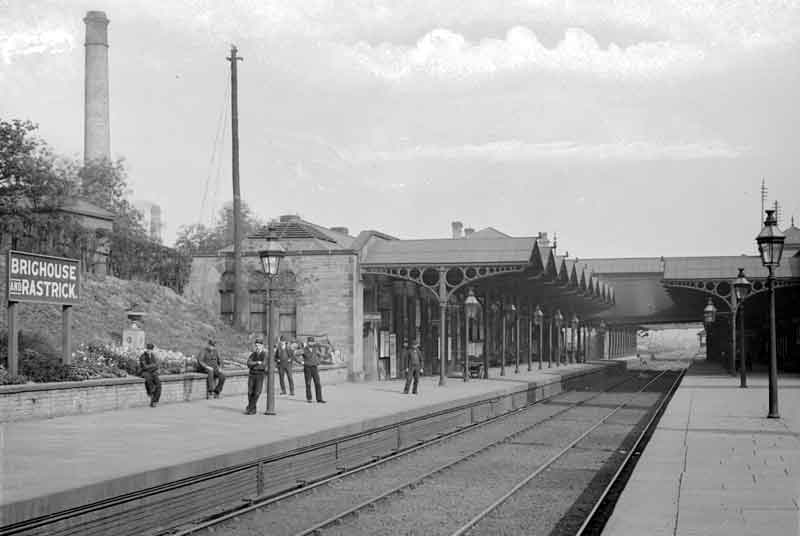
After the 2nd World War, the railways fell into a gradual decline with dated rolling stock and lack of investment. With the continual reduction in passenger numbers, the station eventually closed on the 5th January 1970 but following a renaissance in the 1990’s, a new station was re-opened on the 28th May 2000 not very far from where the original 1840 station once stood.
COMMERCIAL INN
In the early days, the Commercial Inn had its own stables for five horses and a coach house for one carriage. It was frequented by many travellers on the Bradford to Huddersfield turnpike road but became known as a drinking establishment for the many Irish labourers who lived in the town. Thomas Henry Hughes was the longest serving landlord having taken over the Commercial Inn in 1905 and retiring on the 23rd August 1944 after 39 years. He was the chairman of the Brighouse Licenced Victuallers Association for 25 years and was famed for giving a cigar to customers on the first Sunday of each month.
The first landlord that I remember was Newton Pollard, an ex-merchant navy Petty Officer who rang last orders with a ship’s bell. Always smartly attired, usually with a pristine white shirt and bow-tie, Newton was from the ‘old school.’ He caught a couple of customers having a quick kiss in the lounge of the pub and told them to drink up and leave. He made us all laugh when he explained his actions by saying, “one thing can lead to another, before you know it people will be fornicating on the new carpet.” His best customers were certainly the Irish lads who would go to the Commercial and quench their thirst after a hard days’ graft on the roads.
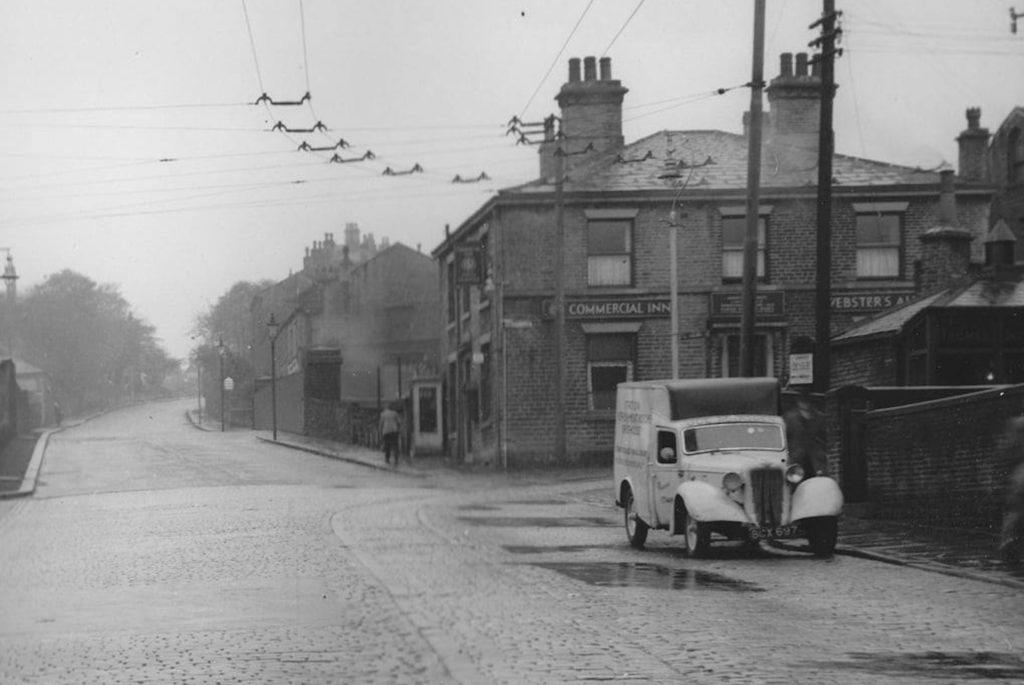
They were only allowed to use the taproom whilst in their work clothes but upon returning after being washed and changed, they would use the lounge. John O’Malley, Ollie Shearing, Mick O’Brien and Tommy Reidy were all regulars and great characters. John had the biggest hands I have ever seen but he was a gentle giant and a lovely man. Newton fell out with each of them on a regular basis but one night we were greeted with a large notice on the door that said, in large capital letters ‘NO IRISH’. The dispute was soon forgotten as they were all back a few days later.
Eccentric was probably the best way to describe Newton. Another sign that he posted on the door was ‘CLOSED DUE TO FAMILY BEREAVEMENT.’ People wondered if his wife, Ivy, had died but when he re-opened a couple of days later, Ivy was working with him behind the bar. Newton was wearing a black armband over his immaculately ironed white shirt so when people enquired into his sad loss, they were told that his German Shepherd dog had died. Some customers were quite relieved as it would often lie in front of the bar where customers wanted to stand but no-one dare give it a gentle kick to move it on.
The pub now goes under the name of both the Commercial and Railway, the latter name being that of a former hotel on Birds Royd Lane, opposite the old railway station. It now goes under the name of Royd House.
RAILWAY SAW MILLS
Across Gooder Lane from the Commercial was Thomas Bottomley’s Railway Saw Mills. Thomas lived from 1815 to 1896. The company was established in Brighouse in 1836 as a partnership called Greenwood & Bottomley but the partnership was dissolved in August 1848. Thomas’ premises were at a place known locally as Ball Flash which was between King Street and Bethel Street. One of the stories regarding how the Ball Flash name came about was in 1855 when William Drake fired a gun up his chimney to clear the soot but he ended up setting the chimney on fire which damaged not only his own premises but that of Thomas Bottomley, his neighbour. Thomas lost his tools, workshop and cottage in the fire.
The company moved to the Railway Saw Mills in 1864 where it grew and prospered into the largest timber merchants in the area for many years. Thomas Bottomley was a member of the Rastrick Local Board and of the Bridge End Chapel where he was eventually buried. His son, James Bottomley was a councillor for the Borough of Brighouse when it was inaugurated in 1893 and he took over the business from his father. The company carried out lots of work in local pubs, churches and businesses. James died in 1914 aged 73 years.
There must have been many accidents on the saw mill machinery over the years but one of the strangest accidents was in August 1923 when Albert Briggs, a steeplejack from Oldham was killed whilst inspecting the chimney at the Gooder Lane yard. A brick was dislodged, and it hit Briggs on the head, killing him instantly.
AIRE TERRACE CO-OP
A short distance up Huddersfield Road is Railway Street, located on the south side of the railway bridge. On the corner of the two roads is the Co-operative Funeral Services which was formerly a Co-op store known as the Aire Terrace branch. It was opened on the 29th November 1889. The adjoining house was later incorporated into the store but the upper storey has long since been removed. However, the famous co-op beehive carving remains in the stonework above what used to be the angled corner doorway on Railway Street. The bee-hive symbol was adopted because bees signified industry, business, perseverance, co-operation and unity. The Co-op also believed that the hierarchical, highly organised social order of the beehive had similarities with human society.
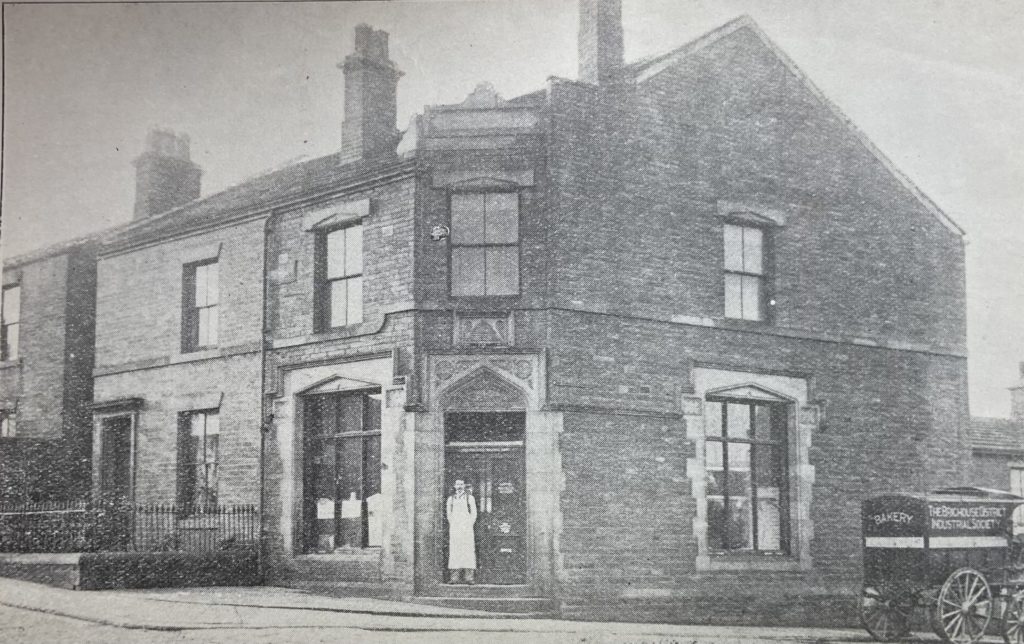
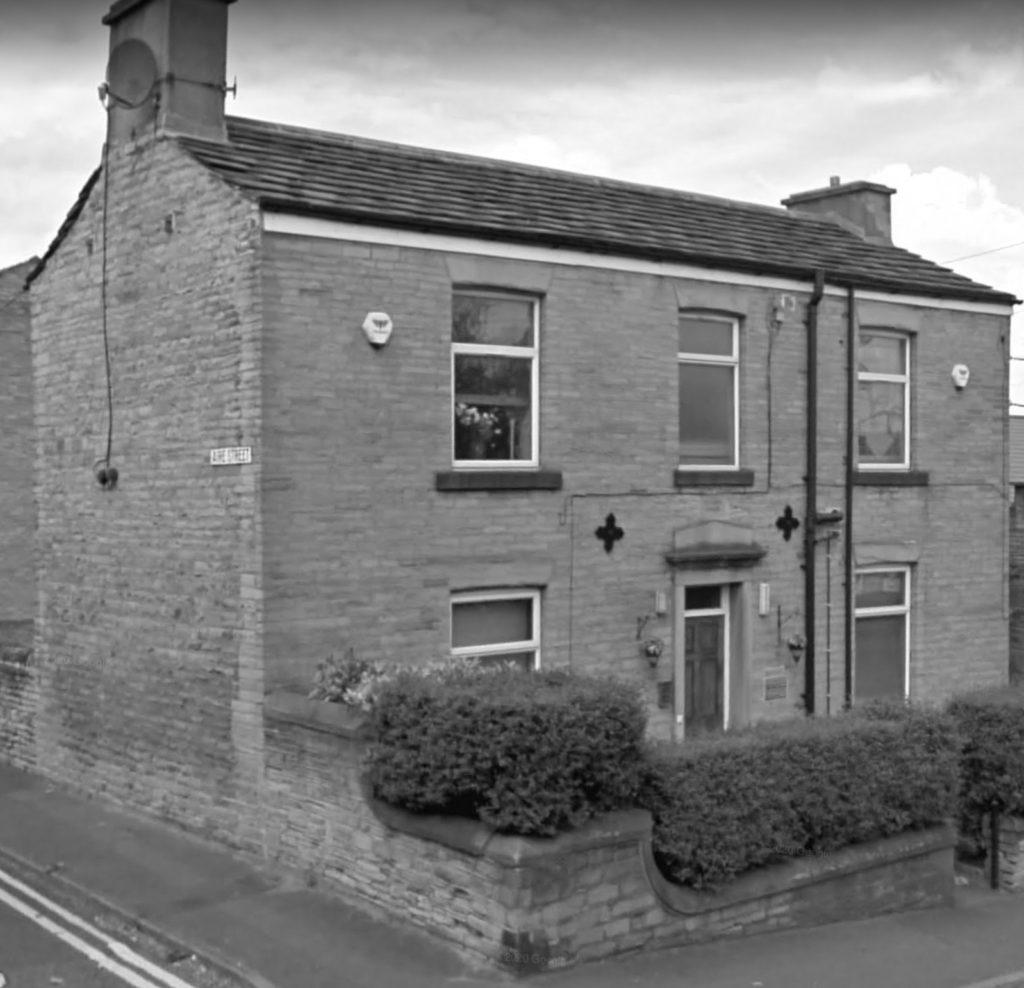
STATION MASTER’S HOUSE
The detached building next door to the Co-op is named Station House and was the old Brighouse railway stationmaster’s house. Arthur Horsfall was the last stationmaster who lived in the house at the side of what is now the co-op funeral services. As young lads, we spent many hours trainspotting, sitting on the railway embankment beyond Lords Lane, overlooking the engineering works of J. Blakeborough & Sons, with the rail tracks in-between. It was a great location to watch the trains but none could beat the actual railway station. But this came with the tricky problem of how to get onto the station platform without being spotted by the eagle eyed Mr. Horsfall. Our adventure always ended with the same result, Mr. Horsfall catching us and throwing us out onto the street because we didn’t have a platform ticket. On the rare occasions that we bought a ticket, I think they were one old penny from a machine on the wall inside the entrance hall, Mr. Horsfall would still find an excuse to throw us out, usually because we were misbehaving (according to him).
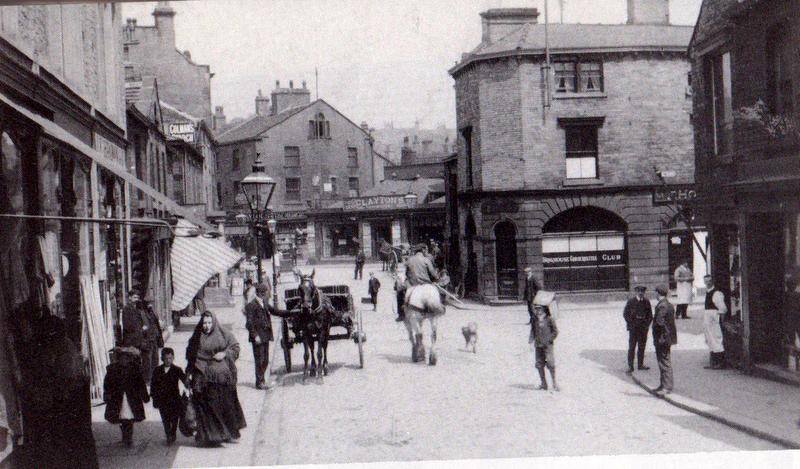
CLIFFE ROAD – THE CLIFFE
We now travel down Huddersfield Road, over the railway bridge and past Gooder Lane before turning left into Cliffe Road where we find the former Brighouse Conservative Club, originally known as The Cliffe. The Conservative Club started life in 1880 in a building situated at the side of what was until recently (2020), Barclays Bank. It closed in 1894 after dwindling membership but the Conservatives continued to function at the Brighouse Borough Club until they acquired new premises in October 1906 at Holroyd Buildings which were located where the roundabout and flowerbed is now positioned in Thornton Square, very close to where the Conservatives had formed in 1880. In the photograph to the left, which was taken from the Anchor Bridge (the Black Bull is just beyond the striped awning on the left of the picture), the entrance door and arched widow of the Conservative Club in Holroyd Buildings are visible. The single storey building (Clayton’s), just beyond, was the location of the original club premises. In 1912, the club moved to the premises at Cliffe Road, leasing the detached house from the Lancashire & Yorkshire Railway Company. This company was taken over by the London, Midland & Scottish Railway in 1923 and they became the new landlords until 1930 when they sold the building and land to the Conservatives for £550. A bowling green was added in June 1914 and was opened by Ald. Robert Thornton.
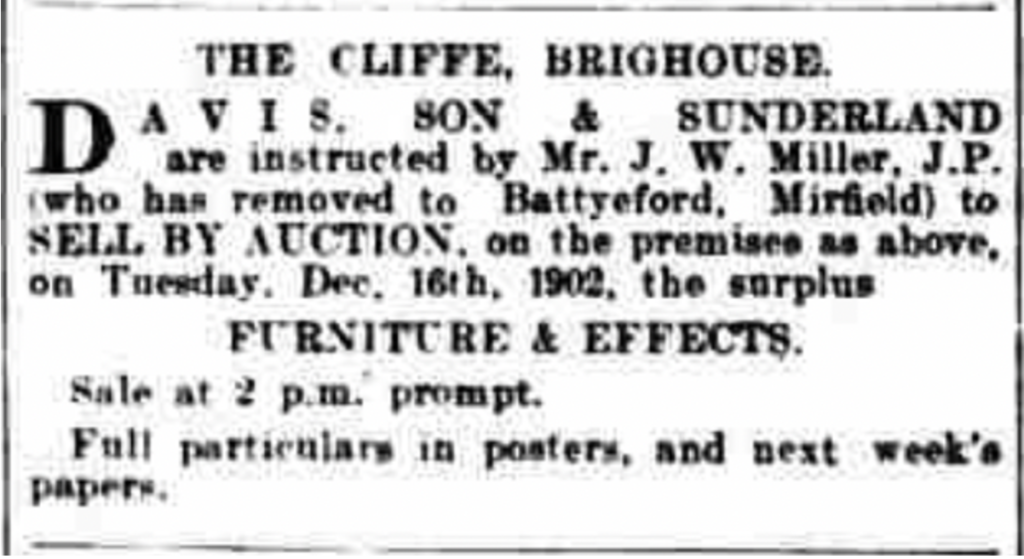
The Cliffe started life as a private house and was built in 1861 for the Thomas Richard Sutcliffe, a corn miller who owned T. R. Sutcliffe & Sons of Brighouse Mills on the opposite side of the River Calder. Brighouse Mills was later sold to Thomas Sugden, another Brighouse corn miller who made the name of Sugden’s Flour Mill known throughout the town and beyond . A letter ‘S’ is carved into the stonework of the ornate surroundings above the front door. Sutcliffe died just three years after the house was completed but his wife and son continued to live there until 1877. Edward Goodall, a card manufacturer with A. Goodall & Son, Brighouse was another occupant until he also died there in 1890. The last family to occupy the premises as a private house was John Watson Miller, the founder of Miller’s Oils on Rastrick Common. He is shown on the 1901 census an oil manufacturer and merchant and is living at The Cliffe with his wife, Hannah, their two sons and two daughters, his mother-in-law and a servant girl. In December 1902, Miller auctioned the property whereupon it was sold to the Lancashire & Yorkshire Railway Company. One of the Miller children, Douglas went on to become the President of the Conservative Club for many years.
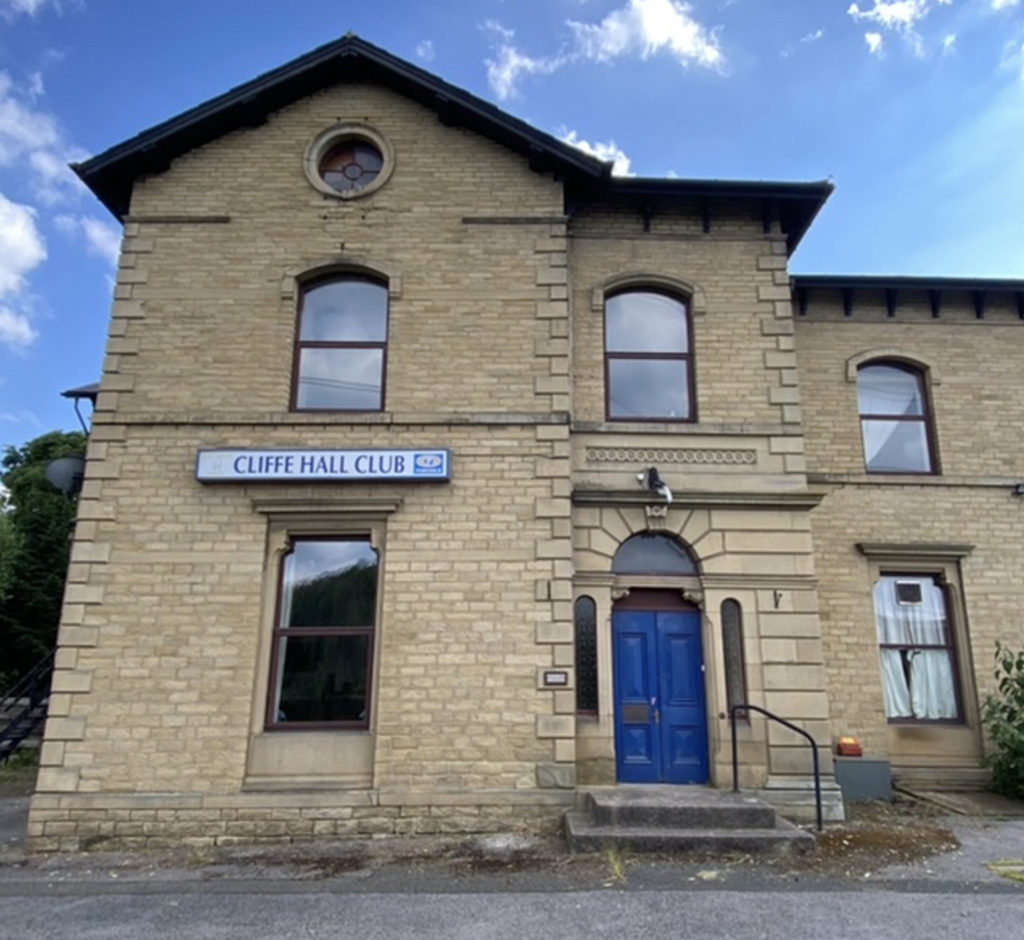
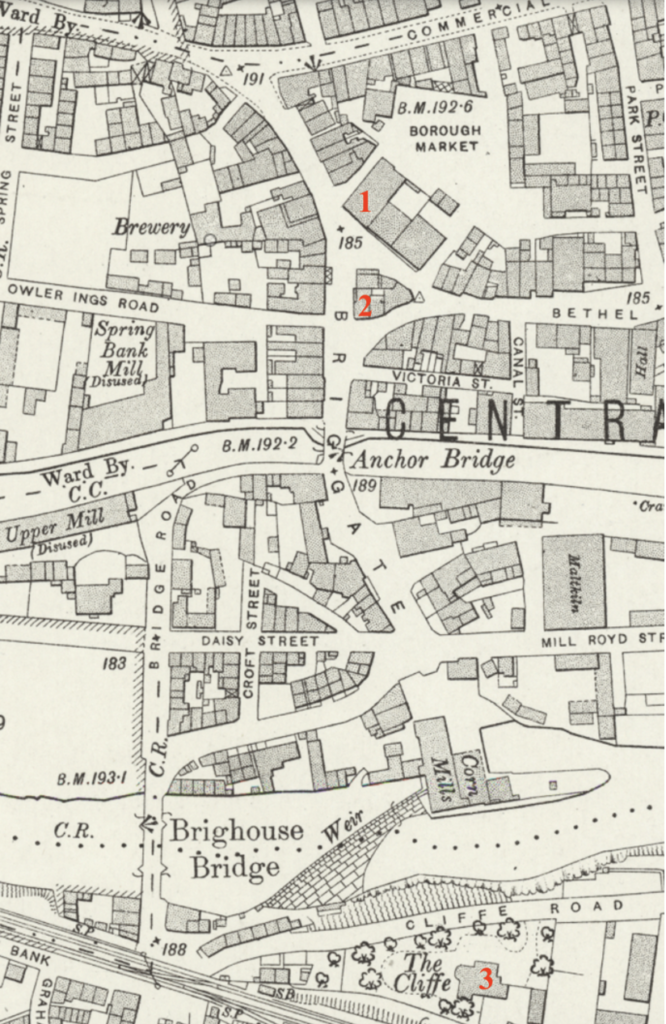
In 2000, the club ceased its political affiliation and was re-named Cliffe Hall Club. The three different locations of the Brighouse Conservative Club can be seen on the map above.
Following the forced closure of many hospitality venues due to the 2020 Covid pandemic, the Cliffe Hall Club committee decided to close the business in the following year. As this article is being written in July 2021, the potential purchaser has indicated that he wishes to return the building to being a private dwelling for himself and his family.
YORK TERRACE
Moving down Cliffe Road, several cottages used to be located in the triangle of land between the club and the railway bridge at Bridge End. The end of the old railway station platform was located to the rear of these houses.
There were further houses on the opposite side of Cliffe Road which fronted onto the river. They were known as York Terrace and were accessed by a track that ran to the rear of the former Duke of York public house. As they were in such close proximity to the river, the houses were often flooded and, being built on a hillside, suffered greatly from damp. They were eventually demolished around the same time as the Duke of York in 1933.
The photo below shows the houses at York Terrace with the Conservative Club in the top left, above the road level.
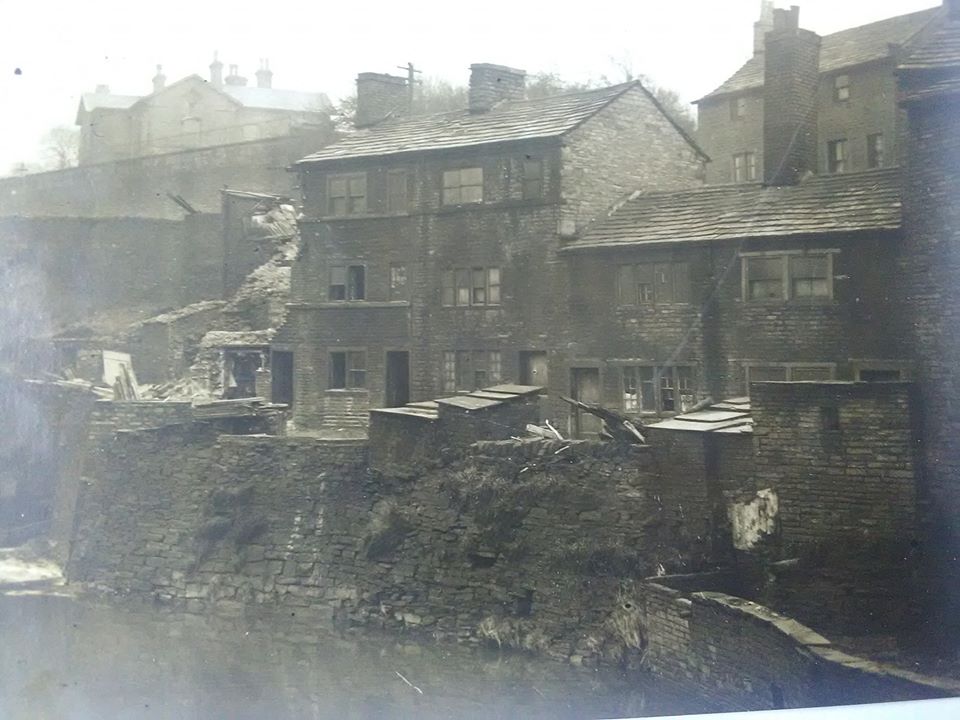
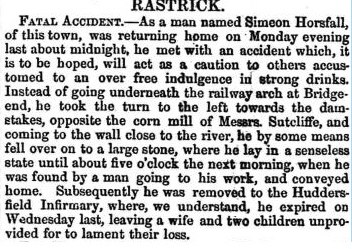
YORK TERRACE FATAL ACCIDENT
On the 29th August 1853, Simeon Horsfall was making his way home from Brighouse, somewhat worse for drink, when he took a wrong turning at the railway arches and ended up on York Terrace. He fell over a large stone and laid unconscious for several hours until being found the next morning. He was taken to hospital but died two days later from his injuries. The Huddersfield Chronicle newspaper warned people of the dangers of over indulgence in strong drink as this sad story resulted in Horsfall ‘leaving a wife and two children unprovided for to lament their loss.’.
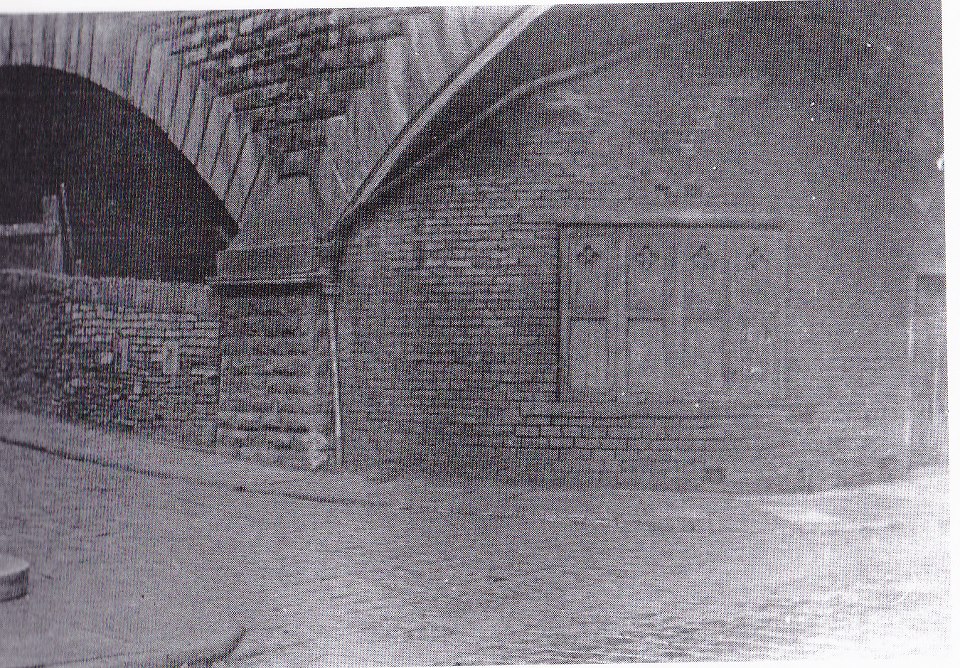
RAILWAY ARCHES & SCOTTY BANK
Underneath the Bridge End railway arches, the pavement is quite wide. This is because it was once the location of a shop, pictured on the left. It was occupied by a cobbler prior to its demolition.
It was at this location in 1887 where the road was barricaded by the good people of Rastrick, preventing the residents of Brighouse from coming over the river bridge to join in their Queen Victoria Golden Jubilee celebrations. Incomers were not welcome at the Rastrick party.
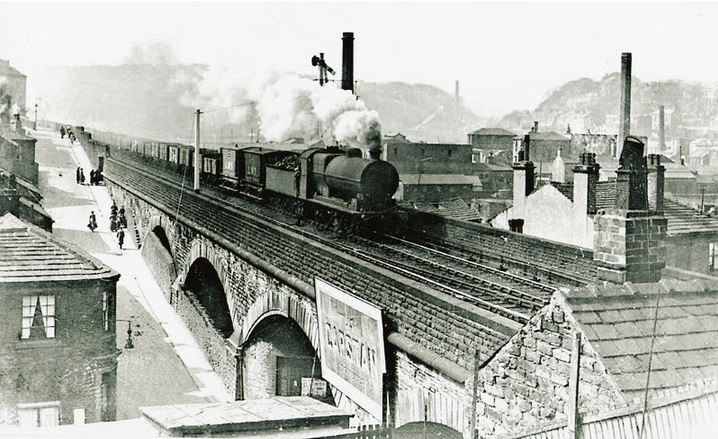
Heading up the hill of Scotty Bank, adjacent to the railway arches, the road bears off to the right onto Lillands Lane. On the left side of the road was the Ring O’ Bells public house. The name is always the subject of argument as many people think that the Ring Of Bells pub that was on Commercial Street in Brighouse, was also called the Ring O’ Bells. This Lillands Lane hostelry closed on the 31st March 1961 and was demolished soon afterwards. It was frequented by Albert Muir from Gooder Lane who used to clog dance on the tables whilst playing the violin.
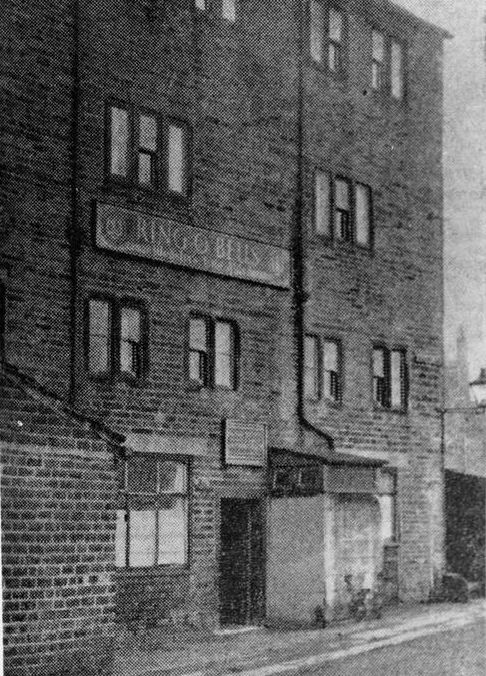
LILLANDS LANE
A short distance along Lillands Lane is Stoney Hill and we will return here shortly. This area was known as Little Woodhouse and housed many of the delvers, masons and other workers associated with the Longroyd and Lillands stone quarries during the Victorian era. A little further to the west is the Oaklands estate. In 1945, Councillor Gilbert Lawson, chairman of the Brighouse Council Housing Committee, commenced a programme of new social housing in the Borough which resulted in many new ‘council estates’ being built. One of these was Oaklands which was erected between 1956 and 1957.
In December 1899, the railway wall on Lillands Lane was packed with people who were vying for the best vantage point in order to catch a glimpse of a passing locomotive. The train had earlier left Halifax and was fully laden with soldiers from the Duke of Wellington Regiment, including many local lads from Brighouse and Rastrick. Their final destination was South Africa where they would fight in the Boer War. The Rastrick residents wanted to ensure that they gave the lads a good send off as they passed through the township.
On the 21st October 1870, at this same location, near to Lillands farm, the Huddersfield bound train smashed into the rear of the stationary Wakefield and Normington train, which was waiting at a signal before entering into the station. The guards van was completely destroyed and the rear carriage was also badly damaged and derailed. The gas cylinders used for lighting also exploded resulting in the death of one man whilst twenty other people were injured.
Lillands Farm is located on the opposite side of the railway and is only accessible via a bridge. The farm pastures lead down to the River Calder at Brookfoot and have been subject to many devastating floods. The farmhouse is a grade two listed building and has the date of 1741 engraved into the stone above the door but there has been a farm at this location since medieval times.
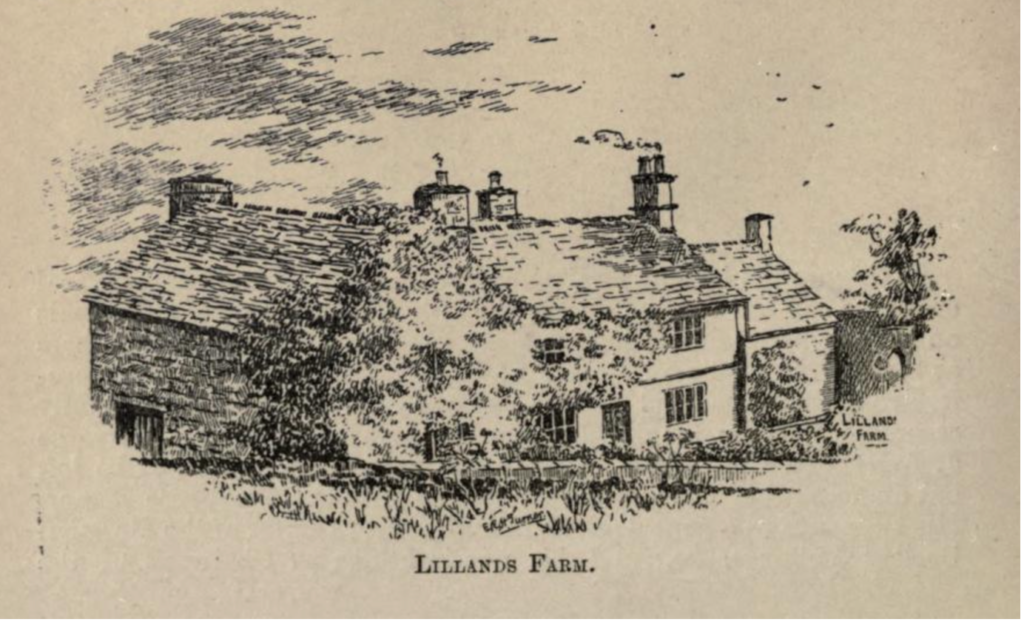
The below photo is taken from the top of Lillands Lane looking down onto some of the long gone mills of Brighouse. The low storey mill in the centre is the Atlas Mill which burnt down in 1898. Owler Ings Mill, which was demolished in the 1970’s is immediately behind whilst Broadholme Mill, destroyed by fire in 1932 is to the right. The view would be therefore much different today but unfortunately, large trees on the left of the Lillands Lane have totally obscured what would otherwise be a fine vista.
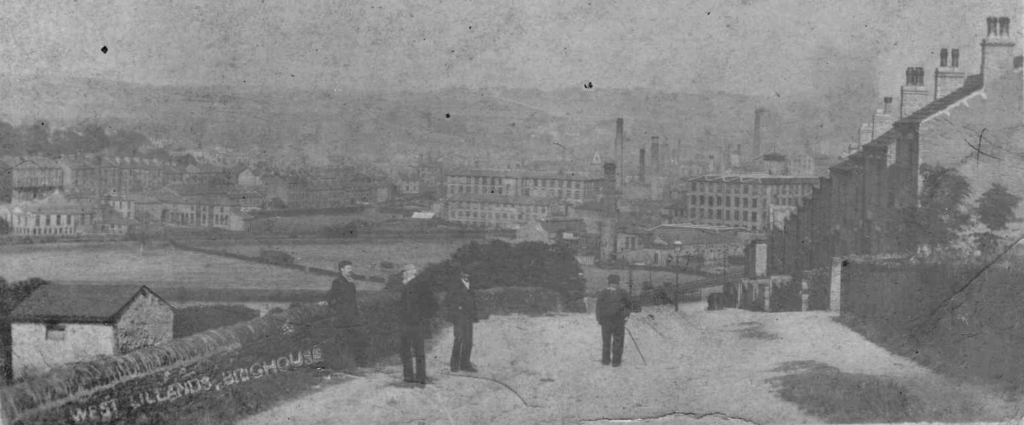
The below photograph shows the area where the stone from the quarries at Longroyde and Lillands was transported to a wharf on the river on wooden carts. The delvers track is still visible through the trees to this day despite the wharf not being used for over 125 years. It runs diagonally from right to left, down to the river. There is still evidence of the wharf, especially since the river level has dropped following the collapse of the Brookfoot weir in January 2021.
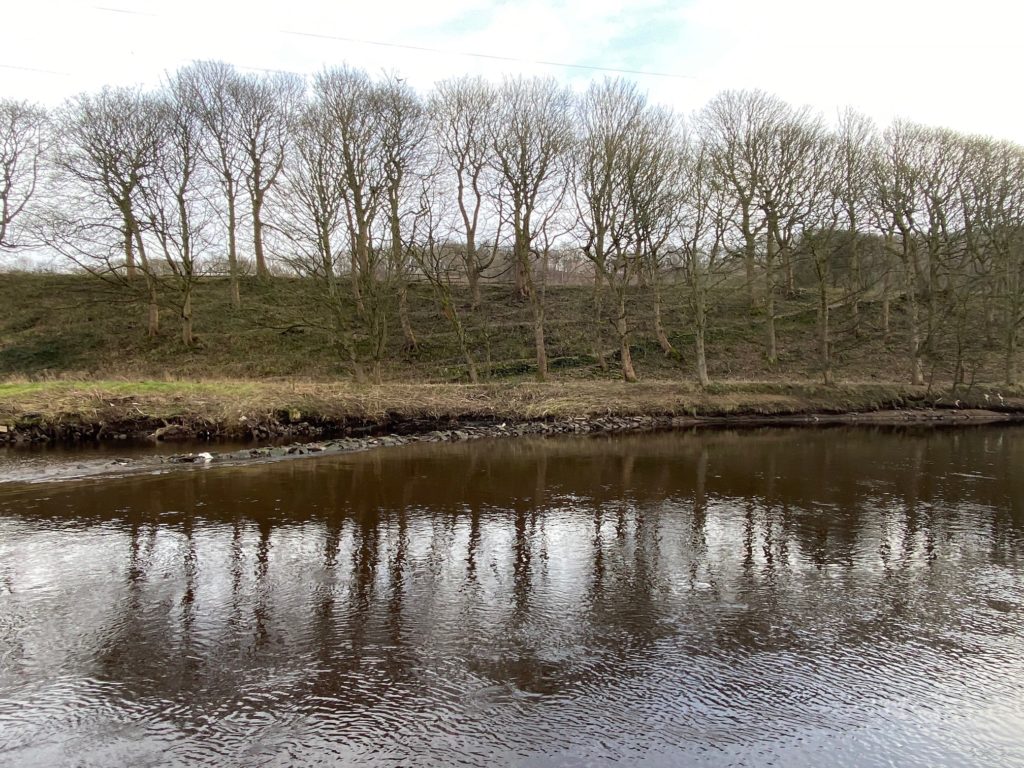
STONEY HILL
We now back-track and return to Stoney Hill. Upon turning off from Lillands Lane, the road rises up a gradient before curving around towards Thornhill Road, an area that used to be known as Brighouse Fields despite being in Rastrick. It is over 150 years since there were fields around here but some green spaces have returned as many old buildings have been demolished and only a handful of the old Victorian houses remain on Stoney Hill. Thomas Street is immediately opposite but our journey takes us to the left along Thornhill Road.
There were many shops in the area to service the numerous residents and even a second-hand piano dealer and tuner lived just along the road at Rose Villa. His name was Alfred Holden Robinson who lived from 1882-1961. The colour advert above is from my grandfather’s collection of glass slides that he used to project onto the screen of the Albert Cinema in the early 1930’s where he worked as the projectionist for around four years. Alfred’s father was also called Alfred Robinson and he was the founder of the Victoria Iron Works, Brighouse in 1868. He died at Rose Villa on the 8th December 1913.
Another man of note who lived at Rose Villa was Thomas Dearnaly, a Quaker, who started his working life as a saddler but somehow entered into the land agency business. He was mentioned on the 1874 advert for the auction of land at Newlands, that was covered earlier in this story. he died on 26th October 1878 aged 81 years and was buried in the Quaker cemetery off Huddersfield Road.
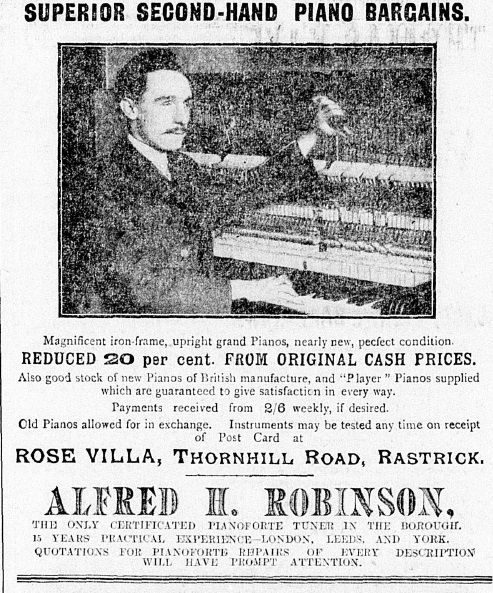
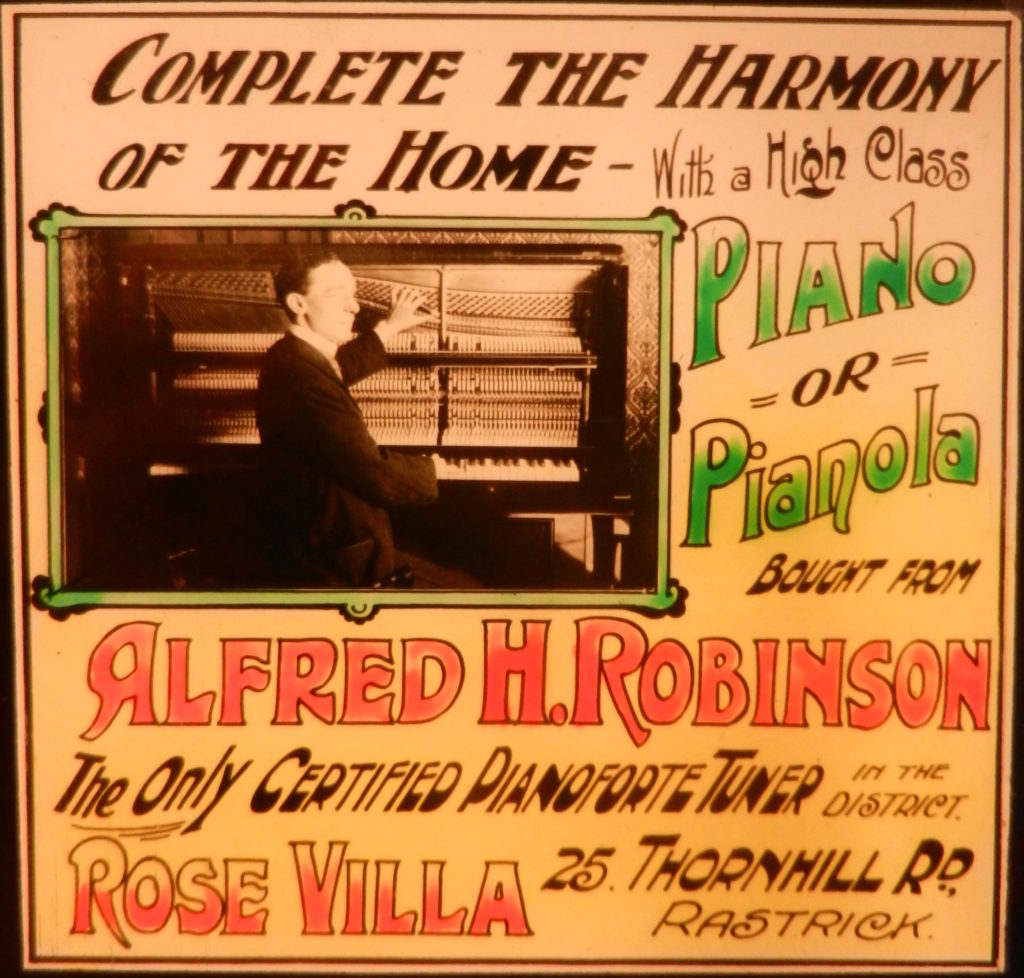
BRIGHOUSE FIELDS CO-OPERATIVE STORE
A little further down the road was the former Brighouse Fields Co-operative Store which was opened on the 4th January 1886. This is the third store belonging to the Brighouse District Co-operative Society that we have discussed on this walk. They certainly had a large foothold in Rastrick, where there was an opportunity to greatly increase their business, such were the numerous dwellings in the region.
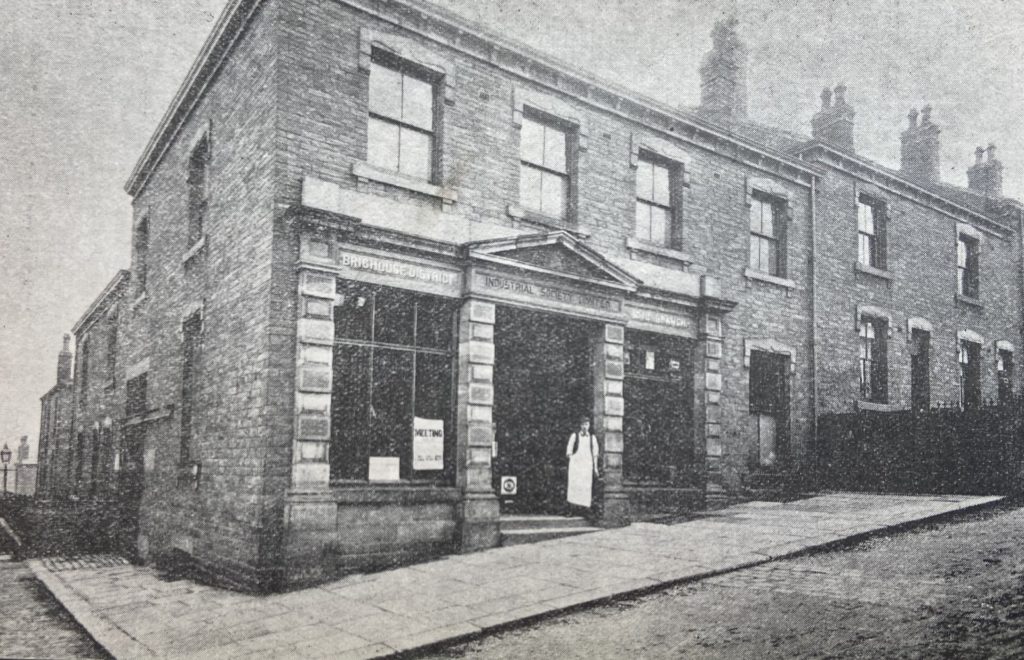
GEORGE STREET TO BRIDGE END
We now turn right into George Street, a road that has retained its original cobbled surface from the 1860’s. The cobbles were more than likely made at Lower Edge as I have seen evidence of several different small quarries at that location, supplying such items to the Rastrick Local Board who dealt with paving the roads in the days prior to the Brighouse Borough Council. Turning left at the bottom of the steep slope, we enter into Bramston Street, another Rastrick road that was named after a member of the Thornhill family. Thomas Harvey Bramston married Honoria Louisa Thornhill, daughter of Thomas Thornhill of Fixby Hall. He was the head of a family that still own much of the land in Rastrick. Heading down towards the bottom of Bridge End, we enter a small area where the locals of over 100 years ago could have done a pub crawl without having to venture more than a few yards and now, all of them have gone.
The Star is probably the most well-known and it was only this year (2021) when the former hostelry was converted into apartments. The original inn dated back to the late 1600’s but was replaced by the current building in 1885 by the landlord, John Exley Dyson (1835-1909). Dyson who was a partner in the Brighouse Brick, Stone & Tile Company. He married Hannah Lord whose parents had owned the inn from the 1840’s. John Exley Dyson’s name was etched in the fanlight above the front door until the recent developers removed it.
BRIDGE END INNS AND BEERHOUSES
When travelling down Bramston Street prior to 1913, the first beer-house you would have encountered was the Rising Sun (pictured below). It was located in the middle of the road, facing the Star. Traffic and pedestrians had to travel down either side and it was for this reason that the pub met its demise. An increasing number of accidents had occurred as motor transport became more prevalent upon the roads. On the photograph below, the front door of the Star is just visible to the right of the Rising Sun and below the right hand window, some cricket wickets appear to have been chalked onto the wall. Can you imagine children playing cricket in the middle of Bramston Street nowadays?
Two hundred years ago, this area was also known as Salford or Salforth. The reason is unknown but one interpretation is that it was near to the Snake Hill river ford and salt (sal in Latin) was brought along this route from the Cheshire mines whilst being transported eastwards in very early times.
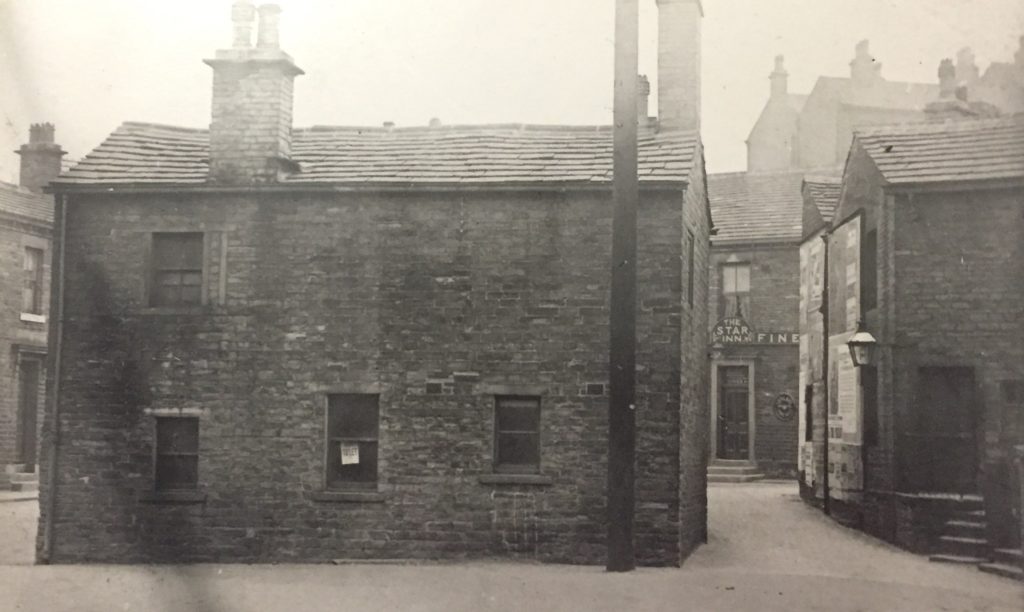
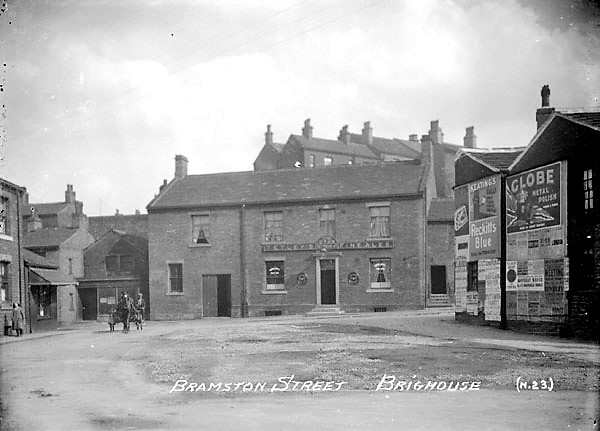
On the picture to the left, the photographer was positioned very close to where the top photo was taken but the Rising Sun has been demolished and the Star Inn is in full view . A third pub, the White Lion is just visible next door but one to the Star. It was the last building before the turn off into Cliffe Road and the railway arches. The pub had six different licensees between 1900 and the 3rd June 1908, when its doors closed for the last time.
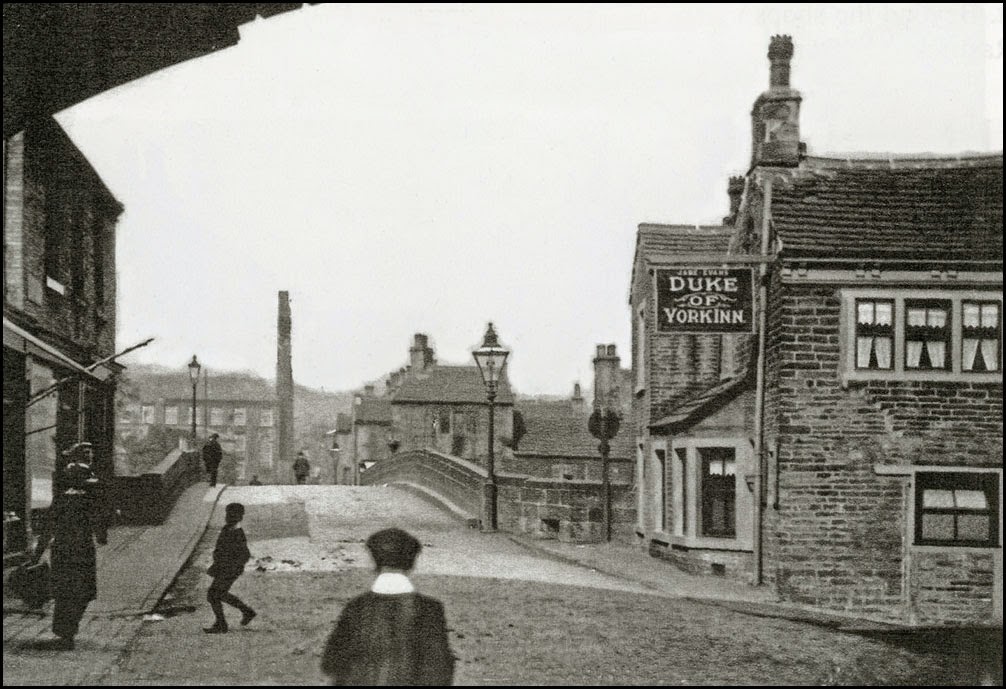
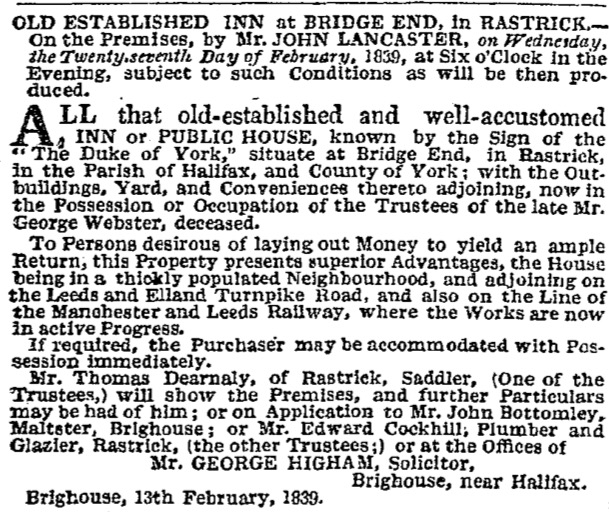
There was a fourth pub which we briefly touched upon earlier in this story. This was the Duke of York (above) which was on the opposite side of the railway arches, adjacent to the river. It was built around 1810 and closed on the 24th December 1927. The entrance to the previously mentioned houses at York Terrace was accessed via a track leading off to the right, at the side of the inn.
In the newspaper advert to the left, which dates from February 1839, the Duke of York was auctioned following the death of the licensee, George Webster. The advert mentions its close proximity to the new railway that was still under construction at that time.
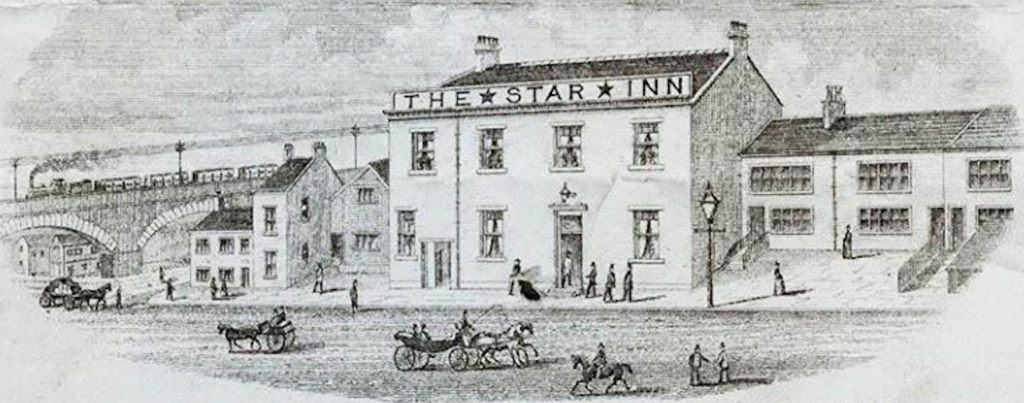
The early drawing of the Star Inn to the left shows some old cottages to the right whilst the White Lion is next but one on the left and the Duke of York is on the opposite side of the arches. It must be dated after 1840 as the railway bridge has been built but artistic licence shows a wide roadway to the front of the Star, probably because including the Rising Sun would have totally spoiled the sketch.
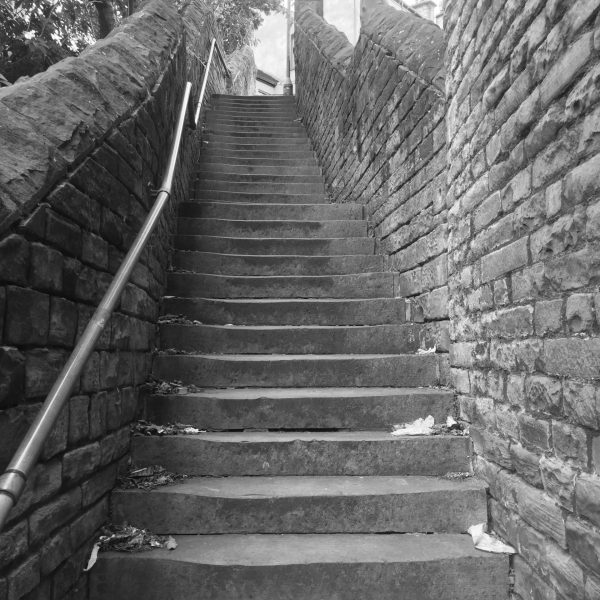
STAR STEPS
Known to everyone, one of the renowned features at this location is the Star Steps. This flight of stone stairs has carried many generations of people between Bridge End and East Street as they travelled to and from their homes and places of work or used by locals who were heading to Brighouse or maybe, just going to one of the Bridge End public houses of their day. The 50 year old photo on the right was taken by Malcolm & Pat Keene.
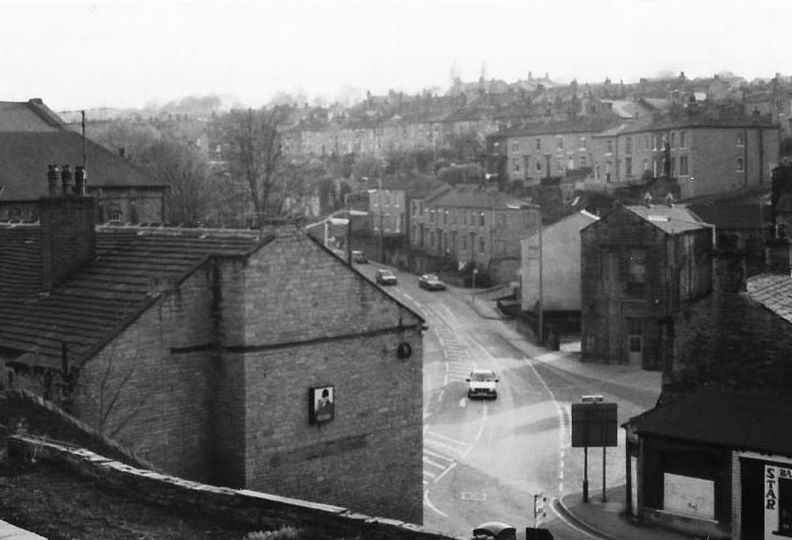
The below picture is taken by a photographer who had his back to the railway bridge and was facing up Bridge End towards Rastrick Common. An ornate gas lamp hangs above the door of the White Lion whilst the two steps leading up to the entrance door of the Star Inn can be seen just beyond.
From here, we continue this journey by travelling up Bridge End. The children’s nursery on the right was the original school belonging to Bridge End chapel and was built in 1821. When the building was extended in 1832, it was built on arches over part of the burial ground and many of the early graves are located under the floor of the present nursery school.
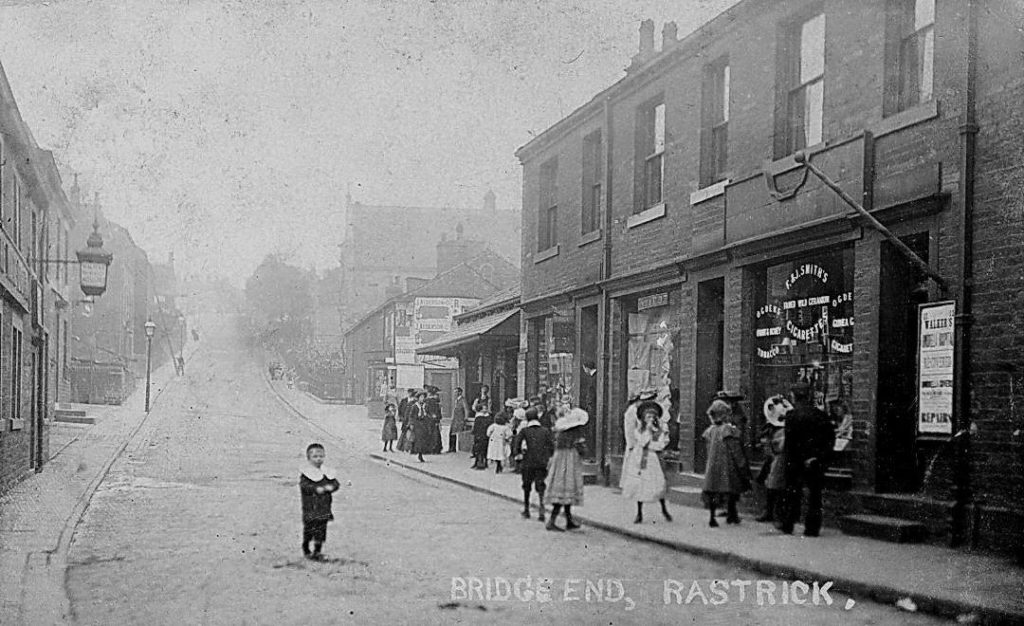
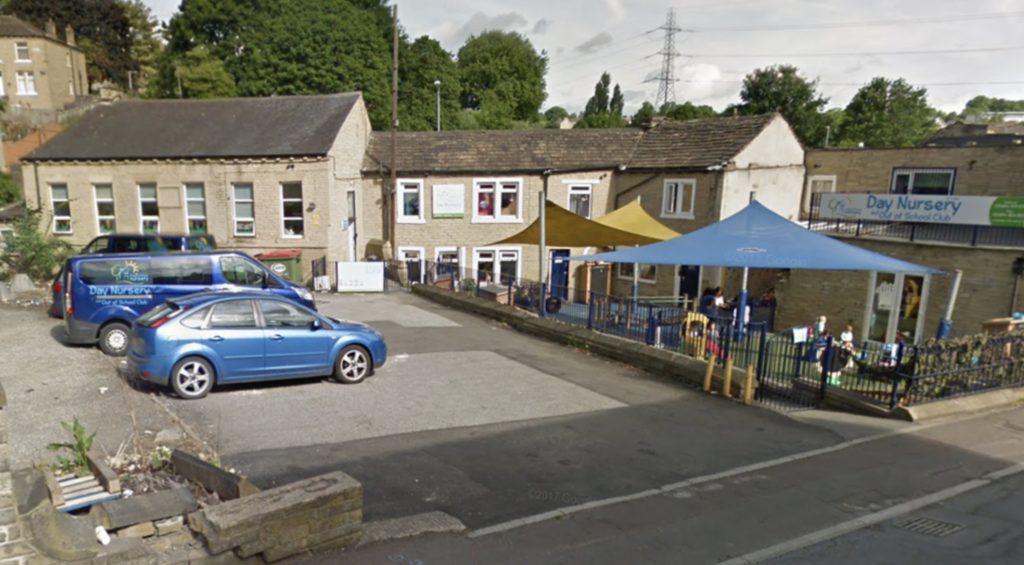
BRIDGE END NURSERY
This photo shows the original school building on the right whilst the 1832 extension is the one on the left with six windows. It is this building that was erected over the burial ground.

The next building is the Quality Koi Carp, where amazing fish costing thousands of pounds each can be purchased or just viewed in the huge tanks.
The building was originally erected by the chapel as the Henry Sugden Memorial Hall and was dedicated to his memory following his death in 1902. Henry was the son of Thomas Sugden, the famous Brighouse corn miller. He became a West Riding County Councillor in 1881 and a Brighouse Borough Councillor in 1893. He was also a Justice of the Peace and an Alderman of the Borough.
The hall was opened on the 26th March 1904 at a cost of £1,800. It was used as an entertainment venue for the Bridge End Dramatic Society and many concerts and fund-raising events were held there over the years.
The newspaper cutting to the left is from 1902, shortly after the subscription fund had been set up. It shows the latest donations and explains that the desire was to raise sufficient funds to pay for a Memorial Hall at Bridge End, a marble bust on a pedestal in the Victoria Free Library, a scholarship to the Yorkshire College and an oil painting, to be hung in the council chamber.
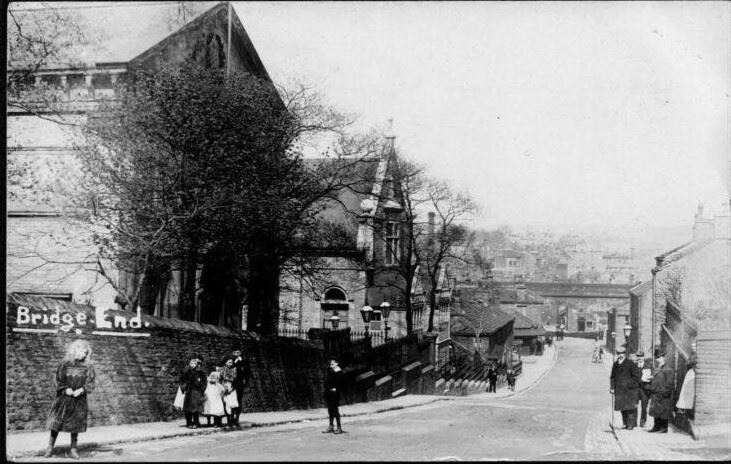
The photograph on the left shows Bridge End chapel with the frontage partially shielded by a tree. Below that is the Sudden Memorial Hall and the railway bridge beyond that. As was usual for that period, word quickly spread around when a photographer was setting up his apparatus and there were always those who were willing to be captured on the image.
BRIDGE END CHAPEL
Next, we come to the former Bridge End chapel which later became a Congregational Church. The original chapel was opened in October 1779 on the section of land where the Sugden Memorial Hall now stands and was gifted by the Duke of Leeds. One of the early ministers was the Rev. John Meldrum in 1785. A native of Scotland, he also farmed a croft at Bridge End which was nicknamed Scotty Croft by the locals, a name, along with Scotty Bank, that remain to this day. Another minister who had a road (Harley Street) named after him was the Rev. Robert Harley. He served the congregation from 1853 to 1868 and was minister when the foundation stone for new chapel was laid in 1854. Rev. Harley was an extremely astute man and was also a professor of mathematics at Airedale College. The new chapel was needed because the old building was too small for the vast numbers of people who attended church in those days. Many of the large mill and factory owners worshipped at the non-conformist Bridge End and they expected their workers to also attend along with their families. The new chapel opened on the 16th January 1856 and could accommodate 1,075 people and this is the building which still stands today though following its closure in 1976, it became the Rastrick Squash Club before being later converted into luxury apartments. Upon completion of the new structure, the old one was demolished and the stone was taken to Brighouse where it was re-cycled for use in the erection of the early St. Pauls Church at the junction with King Street and Police Street (later re-named Lawson Road). My maternal descendants were associated with Bridge End chapel from the days when the congregation used to meet in private houses at Oaks Green, Rastrick, prior to the first chapel being built in 1779. They were still there at the end as my grandfather’s sister, Ada Riley, was the oldest member when it closed in 1976. My great, great, great grandfather, William Bottomley was buried there, as were several of his children, including my great, great grandfather and grandmother. My grandparents were married there in 1928, as were my parents in 1953. Myself and my two brothers were also baptised at Bridge End therefore it still holds some affection with our family.
The photographs below show my parents wedding. Thomas William Eccles married Christine Bottomley at Bridge End on the 6th June 1953. The centre photo is an image taken from the ciné film of their wedding and shows the bridal car arriving at the church with the Star Inn and railway bridge in the background. My grandparents and other relatives are to the right.

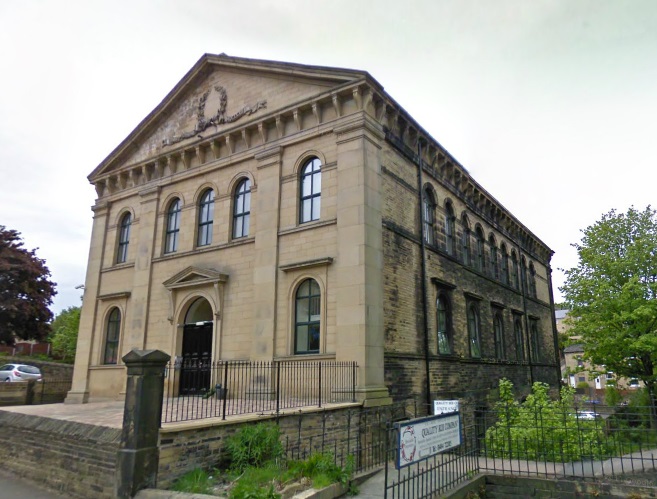
Bridge End chapel in more modern times following its conversion to private apartments. Still looking resplendent after 165 years, with its fine Ashlar sandstone frontage.
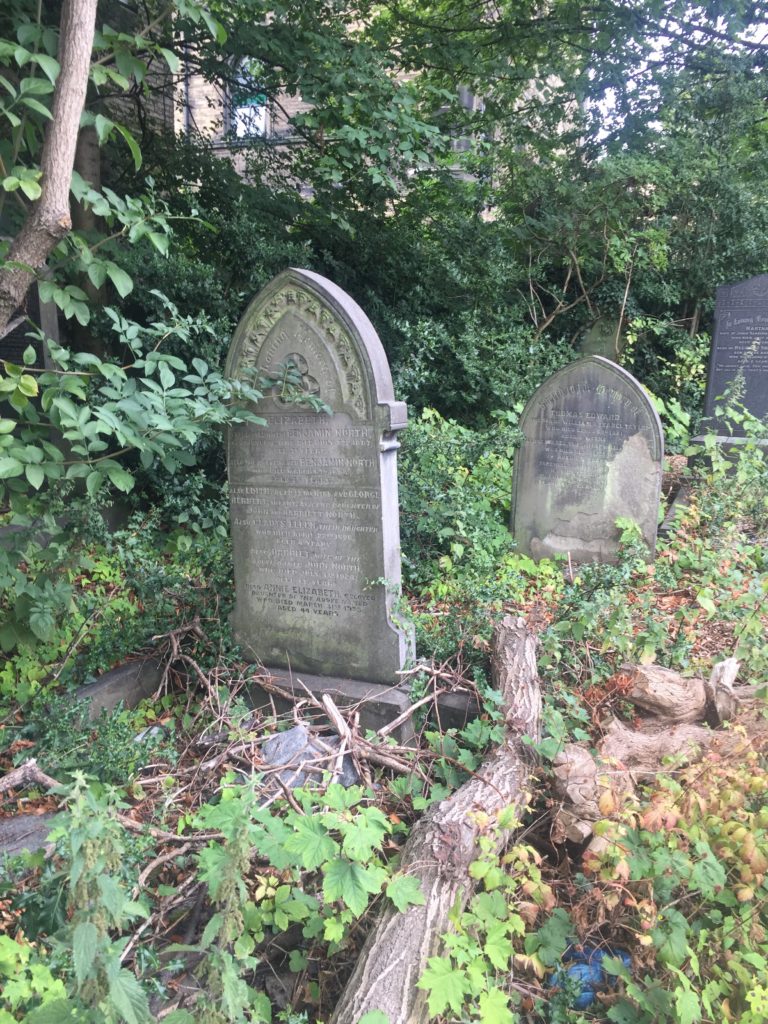
The burial ground at the rear was made into a car park after the closure of the church. The headstones were laid face down and then covered with hardcore and tarmac. Fortunately for the local historian and family history researchers, part of the planning permission decreed that all the gravestone inscriptions had to be recorded. The book went missing in the 1990’s and it appeared to be lost forever but it suddenly turned up when a lady informed me that she thought that she had it. She photographed all the pages and sent them to me and they have now been transcribed and are available on this website, along with links to some other burial records from Bridge End. They can be found at:- https://myrastrick.com/bridge-end-chapel
A small portion of the graveyard at the rear of the Henry Sugden Memorial Hall still exists (pictured to the left) but it is very overgrown and some of the headstones have been broken or vandalised. I have photographed the ones that are accessible and they are also available on this website.
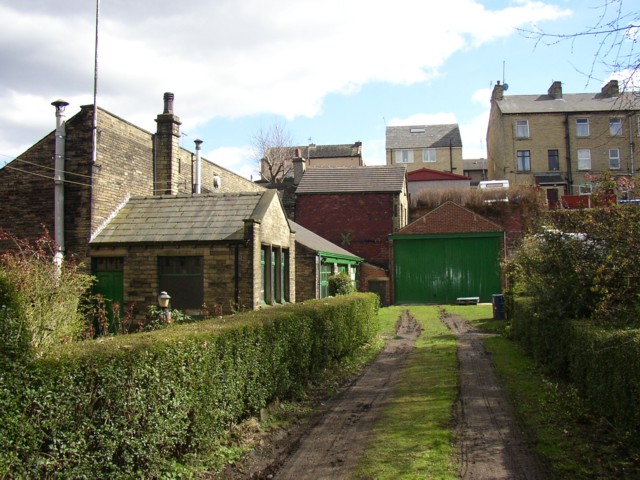
WRIGHT’S BRANDY SNAP
Leaving Bridge End, we turn down Harley Street, which I touched upon earlier. At the junction with Bramston Street, we turn left and make our way up towards the ‘rec’.
The Wright family had been baking biscuits and brandy snap since 1850. Clark Wright and his wife Martha were confectioners at Bramston Street in the mid 1800’s and made brandy snap which became renowned around the entire country. You could hardly go to a fairground without seeing Wright’s Brandy Snap for sale. The couple’s daughter, Martha Louisa (later to become Naylor) continued the business until her death in 1948.
Many people have written about their fond memories of the company on the Memories of Brighouse Facebook page and I too remember going there for a bag of broken ‘bits’, usually after attending at the Brighouse swimming baths.
The business still thrives to this day but many people are not aware of its actual location because it is hidden away at the rear of the houses on Bramston Street just before reaching the recreation ground.
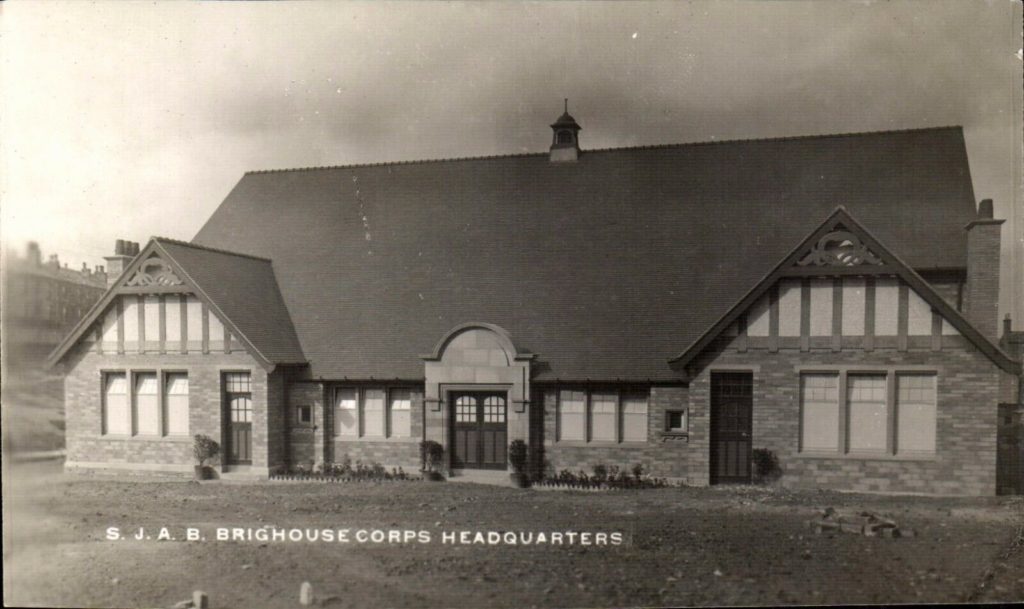
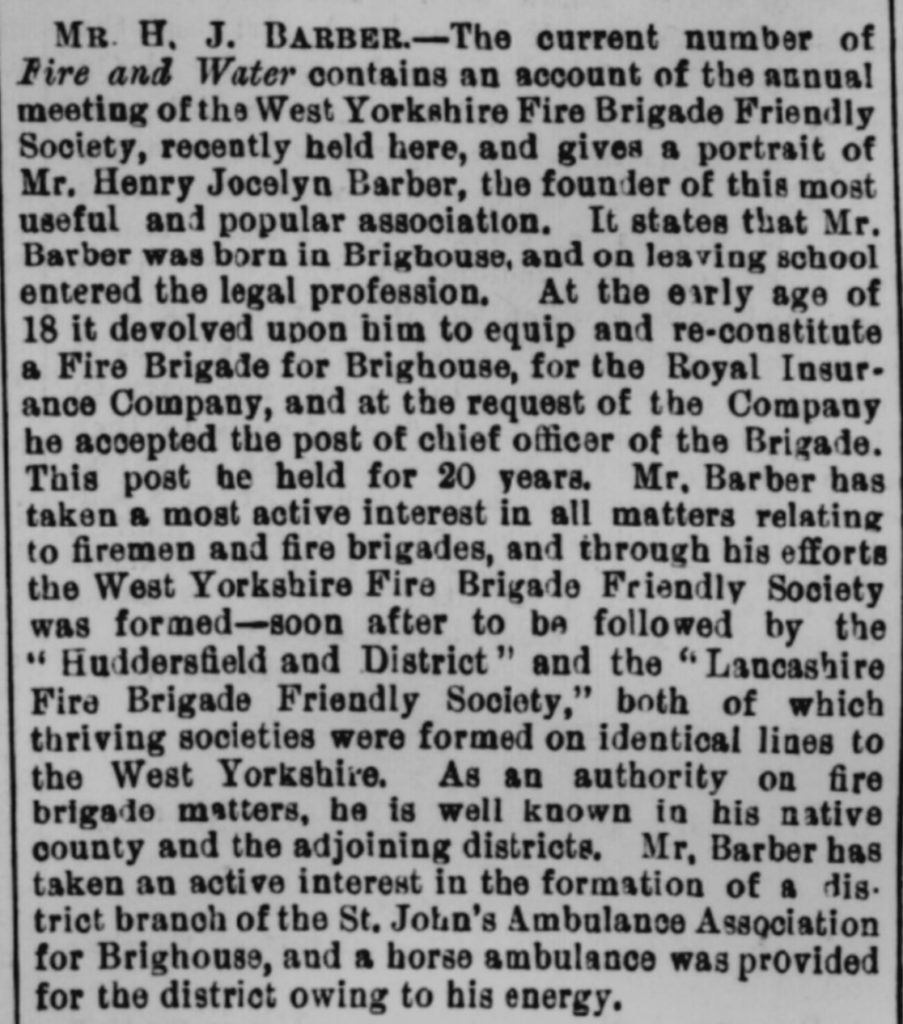
ST JOHN AMBULANCE BRIGADE HQ
In December 1880, the Brighouse News reported upon a proposal to commence a ‘detached class’ of the Halifax St John Ambulance Association. The members received instruction in giving ‘first aid to the injured’ and they expanded by going into local factories and shops where they taught the workers in the basics of First Aid. The initial attempt to form a Brigade appears to have failed but a few years later, a local solicitor, Henry Jocelyn Barber, took a keen interest in ensuring that the Association flourished in Brighouse. Some years earlier, Barber had been principal in forming a Fire Brigade in Brighouse and he went on to raise money through private subscription to purchase a horse drawn ambulance (Report to the left is from the Brighouse & Rastrick Gazette – 14th June 1890). Garden fetes and concerts, including a smoking concert, were organised to raise money for the Association. Despite this, the Association still struggled to keep going until the more enthusiastic members decided to form a Division of the St. John Ambulance Brigade in 1901.
The following year, a Nursing Section was created under the leadership of the Mayoress, Mrs Samuel Edgar Hirst. She held the role of Lady Superintendent and the two divisions joined together to form a St. John Ambulance Brigade Corp on the 14th June 1902. Frederick Fielding Bond became the Corps Superintendent and with his support, they grew from strength to strength. The Brigade needed their own headquarters and money was raised through various methods to reach the required target. One such fund-raising event was a Grand Bazzaar held over four days (7th – 9th and the 11th November 1911). A number of different sites for the Corps headquarters were looked at and in 1913, it was decided that a site at Bramston Street, Rastrick would be the most suitable. In an effort to clear the site quickly, a number of the male Corps members turned up on Easter Monday, the 24th March to take down a 54 foot chimney and boiler house belonging to an old factory, that needed to be cleared. Two months later, on 20th May 1913, Mrs Susannah Smith, the wife of Alderman William Smith of Lands House, Rastrick, laid the foundation stone of the Brighouse St John Ambulance Brigade at Bramston Street, Rastrick. The building was officially opened by William Smith on the 1st August 1914, the very day that Britain declared war on Germany which signalled the start of the 1st World War.
On the 25th September 1914, seventeen of the Corps members were called up active service, several of them worked on the military troop ship, the ‘Oxfordshire’, which made 115 trips and carried over 60,000 injured troops from France, back to England during the conflict. Sadly, some of the male members who went off to fight for King and Country didn’t come back. During this period, Dr. Bond was actively involved in organising the headquarters, along with the mansion houses at Boothroyd and Longroyde to be converted into military hospitals for soldiers wounded in the war and he encouraged many local people to assist the St. John members on a voluntary basis.
By 1937, St. John Ambulance Brigade formed a Corps Band. It went on to become one the premier marching bands in the country between the 1960’s and 1970’s and local residents in the nearby streets could hear them practising when they were out in the open at the band HQ on Bramston Street. In addition to their many local performances, they played at the Royal Albert Hall in London, the British Marching Band Championships and even displayed their talents in Germany and the Netherlands. They eventually disbanded in 1980 and the building was taken over by Charles Wood Funeral Services who carry out their business from the appropriately named St. John’s Chapel of Rest.
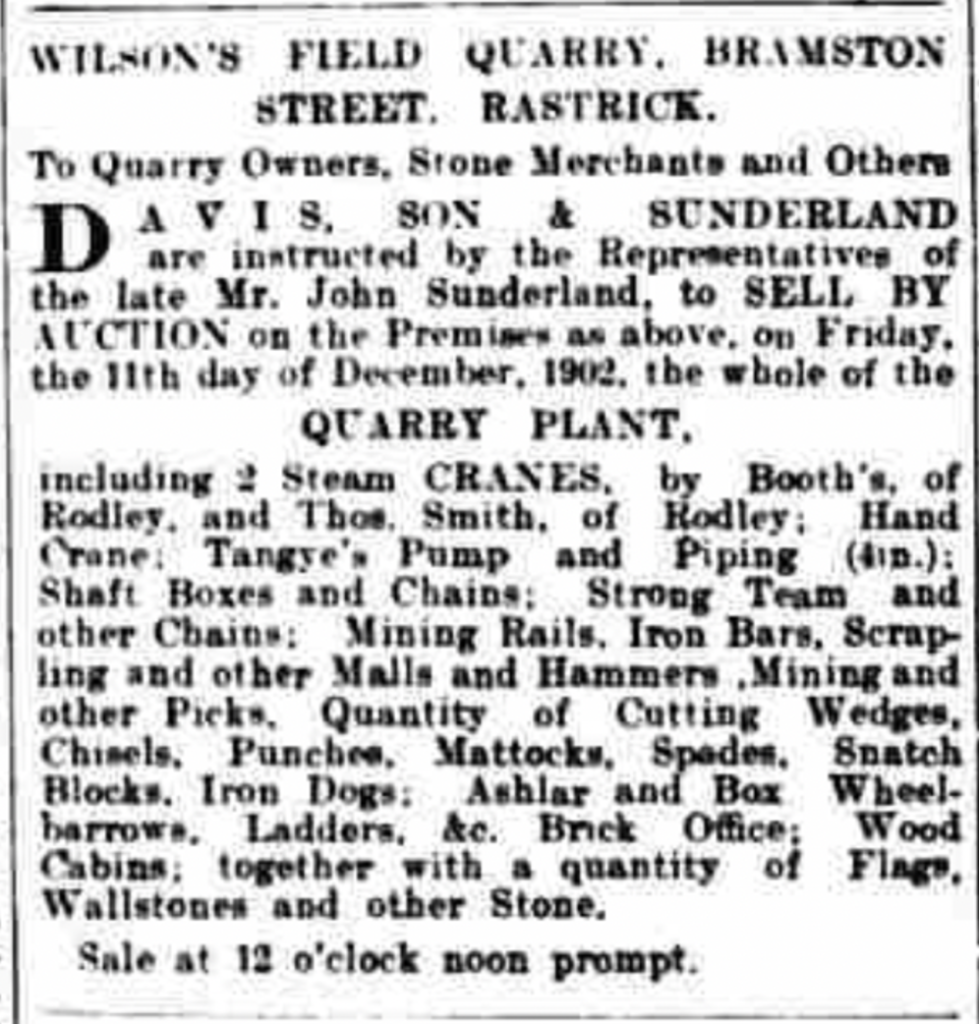
Continuing along Bramston Street, the recreation ground, known to several generations as ‘Brammie Rec’ can be seen on the same side of the road. It was once a stone quarry known as Wilson’s Field and was worked by Samuel Cliffe & Sons in 1896. Following heavy rainfall in October of that year, the stream running through the quarry caused a huge landslip, but the Brighouse News report stated, ‘most of the stone had been got out at this place so the loss of Messrs Cliffe will not be so great as some would suppose.’ This didn’t stop Samuel Cliffe from selling the quarry to a quarryman named John Sunderland of Upper Edge. His business didn’t last very long as in December 1902, the quarry was deemed to be no longer viable, the plant was advertised for sale and that brought a close to stone quarrying at Bramston Street. The land remained waste for several years but following the closure of the nearby Sparrow Park in 1911, the residents complained that there was nowhere to perambulate or for young mothers with children to meet up with each other. The Brighouse Borough Council eventually bought the land and opened the recreation ground on the 20th September 1924.
Across the far side of the recreation ground are a flight of steps that rise up to Brook Street, a street of terraced houses built around 1870 for the mill and factory workers in what was a rapidly expanding township. Following Brook Street to the right, the road goes around a corner and brings us back to the starting point at the former White Horse public house.
I hope you have enjoyed your journey around some of the streets of Lower Rastrick. If you wish to add anything to the story or if you feel that I have got something wrong, please contact me at 1andecc@gmail.com and I will be only to happy to amend this webpage. Thanks for taking the time to read it.
Andrew Eccles – 30th July 2021
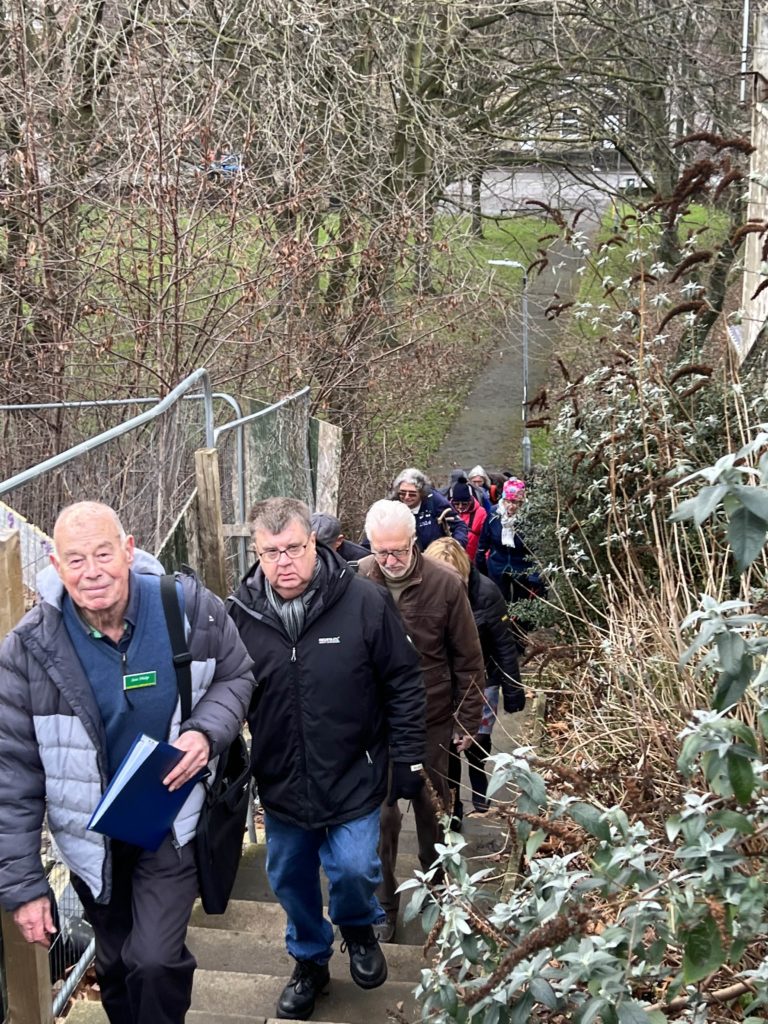
LOWER RASTRICK WALK
Occasionally, walks are organised within the Rastrick area, where members of the public are invited to attend.
On the 16th January 2022, Calderdale Heritage Walks had such a walk led by Ian Philp. It was a pleasant, dry day and twenty-eight people enjoyed a wander around the lower Rastrick district where they learnt about the history of not just the area but of many old buildings including pubs, shops, a church and industrial factories along with information about the coming of the canal and railway.
The photograph shows the walk-leader, Ian Philp, leading the group up the steps from the Bramston Street recreation ground to Brook Street.
If you are interested in other walks with Calderdale Heritage Walks this winter, please click on this link for more details.